Glossary
Plant Care Library
D
Dendrobium Orchid
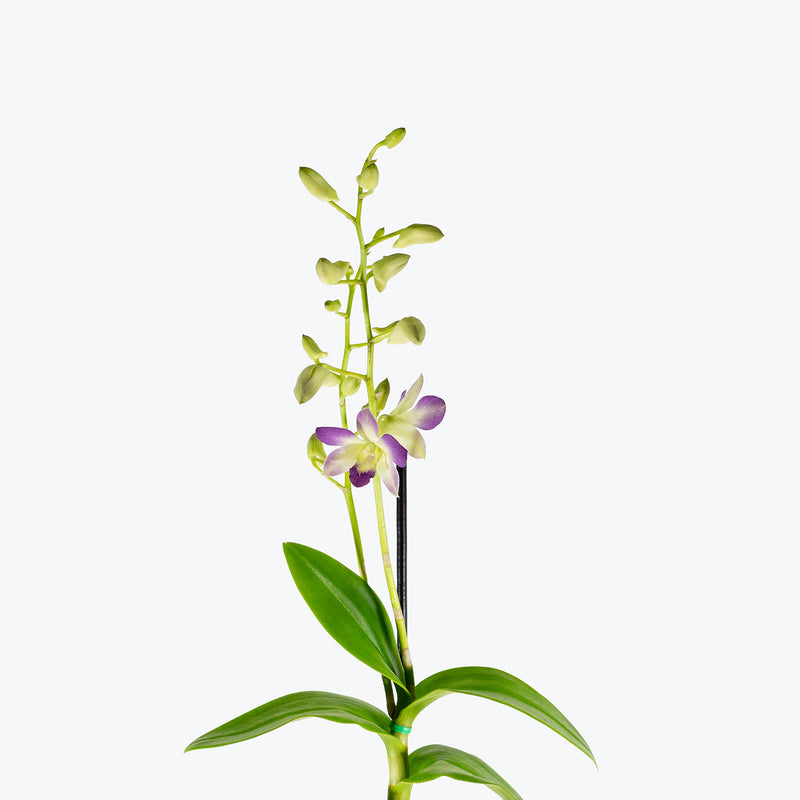
How to care for Dendrobium Orchid
Dendrobium Orchid enjoys some direct sun, but they'll also do well in bright, indirect light. It is best to place this plant somewhere where it will receive some nice morning sun, or a couple hours of afternoon sun, and then indirect light for the rest of the day.
Dendrobium Orchid will thrive in bright light, but also can tolerate medium light. A good medium-light place in your home would be in the middle of a room that has a regular size window. They can be placed anywhere between the middle of the room and the window. Remember that plants will grow based on how much light they receive.
Dendrobium Orchid likes the soil to be relatively dry before the next watering. That usually takes about 1 week in an average home environment, as they are typically potted in a bark mix that allows for quick drainage and good air circulation. It will vary depending on the time of year, your environment and lighting conditions, but for them, it's always safer to underwater or water when you see signs of lack of water (i.e. droopy, floppy, or soft leaves). Expect to water more often in brighter light and less often in lower light.
Dendrobium Orchid will do well in average humidity environments but will appreciate a little bit of humidity if provided, give them a mist daily or get a humidifier.
Use a well-draining orchid mix, and make sure your pot has drainage holes. Dendrobium Orchids love consistent routines — keep their environment stable. After blooming, trim spent flower spikes and continue regular care to encourage future blooms. Fertilize lightly every 2–4 weeks during active growth.
You can feel comfortable having Dendrobium Orchid around your home in the potential case where your pet feels like nibbling on it. However, we typically recommend keeping your pets from eating any of your houseplants..
View PlantDieffenbachia Amy
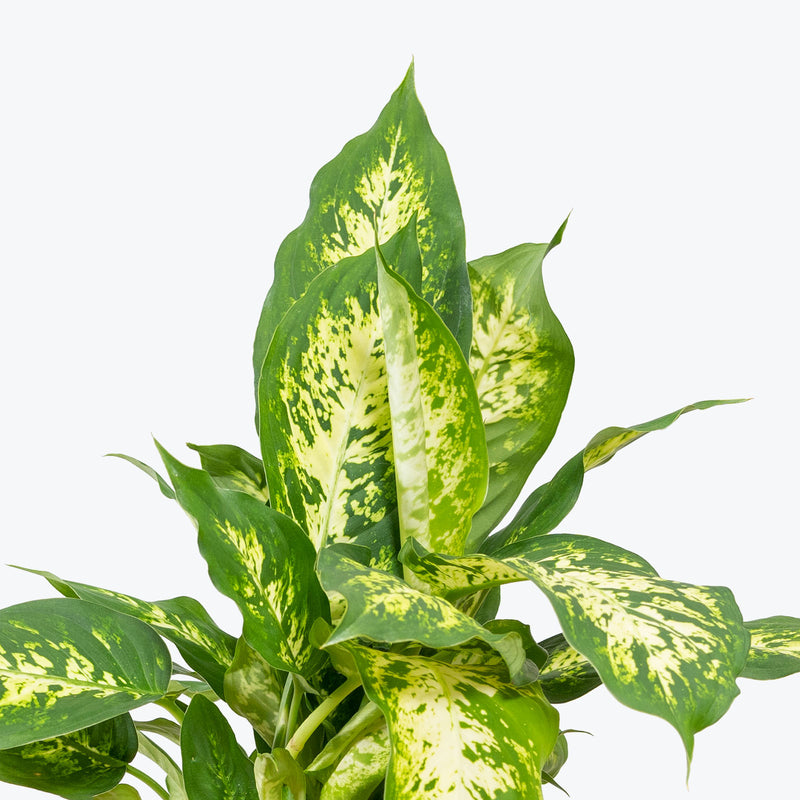
How to care for Dieffenbachia Amy
They should not be in a position to see the sun directly, although early morning or late evening sun is fine. Filtered sunlight through a sheer curtain is best and most homes are comprised primarily of indirect sunlight. The best spot for them is where they do not see the sun during the majority of the day but still get bright, indirect light.
They will do well in medium light but will grow faster with brighter light. A good medium-light place in your home would be in the middle of a room that has a regular size window. Remember that plants will grow based on how much light they receive.
They need to be watered when the top half of the soil is dry to the touch. That usually takes about 1 week in an average home environment. It will vary depending on the time of year, your environment and lighting conditions, but it's always safer to underwater or give the soil a check before you water again.
They will do well in average humidity environments but will appreciate a little bit of humidity if provided, give them a mist daily or get a humidifier!
If you mist it once a week or so it will really help the health of the leaves. Or let it steam in the bathroom once in a while as you relax.
This plant is moderately toxic and can cause some adverse reactions when ingested so it is best to not let your pets eat it, which we advise for all plants in general. The severity of the reaction will depend on how much of the plant is ingested but, if you know your pet typically does not eat your plants, this plant will be suitable for your home..
Learn MoreView PlantDieffenbachia Camouflage
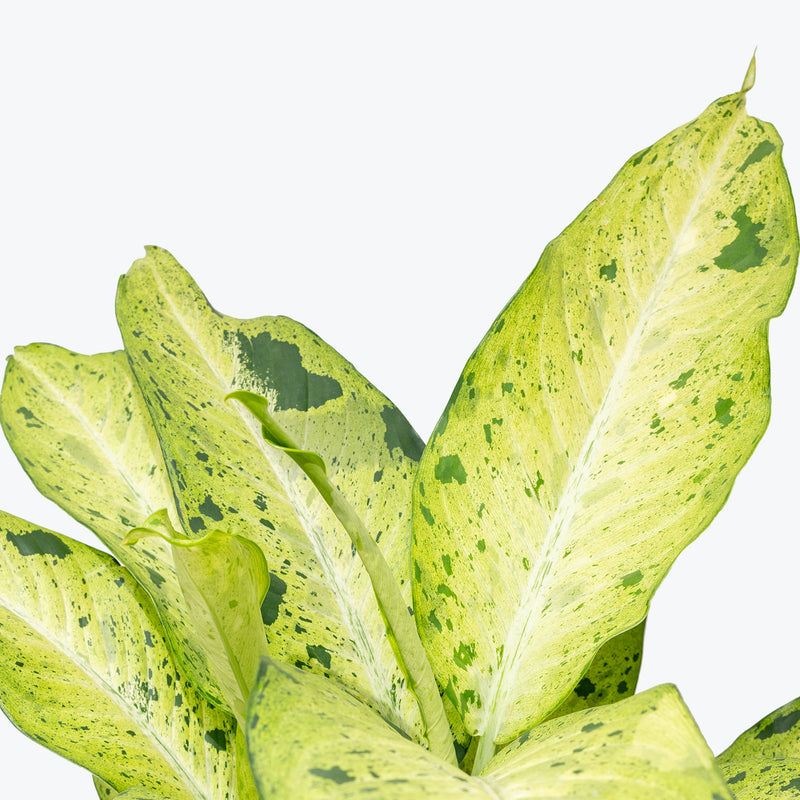
How to care for Dieffenbachia Camouflage
They should not be in a position to see the sun directly, although early morning or late evening sun is fine. Filtered sunlight through a sheer curtain is best and most homes are comprised primarily of indirect sunlight. The best spot for them is where they do not see the sun during the majority of the day but still get bright, indirect light.
They will do best in bright light. A nice bright place inside your home would be on the window sill or a stool that is right next to a window, either with or without blinds, depending on if the plant can handle sun. Remember that plants will grow based on how much light they receive.
They need to be watered when the top half of the soil is dry to the touch. That usually takes about 1 week in an average home environment. It will vary depending on the time of year, your environment and lighting conditions, but it's always safer to underwater or give the soil a check before you water again.
They will do well in average humidity environments but will appreciate a little bit of humidity if provided, give them a mist daily or get a humidifier.
If you mist it once a week or so it will really help the health of the leaves. Or let it steam in the bathroom once in a while as you relax.
This plant is moderately toxic and can cause some adverse reactions when ingested so it is best to not let your pets eat it, which we advise for all plants in general. The severity of the reaction will depend on how much of the plant is ingested but, if you know your pet typically does not eat your plants, this plant will be suitable for your home..
Learn MoreView PlantDieffenbachia Cool Beauty
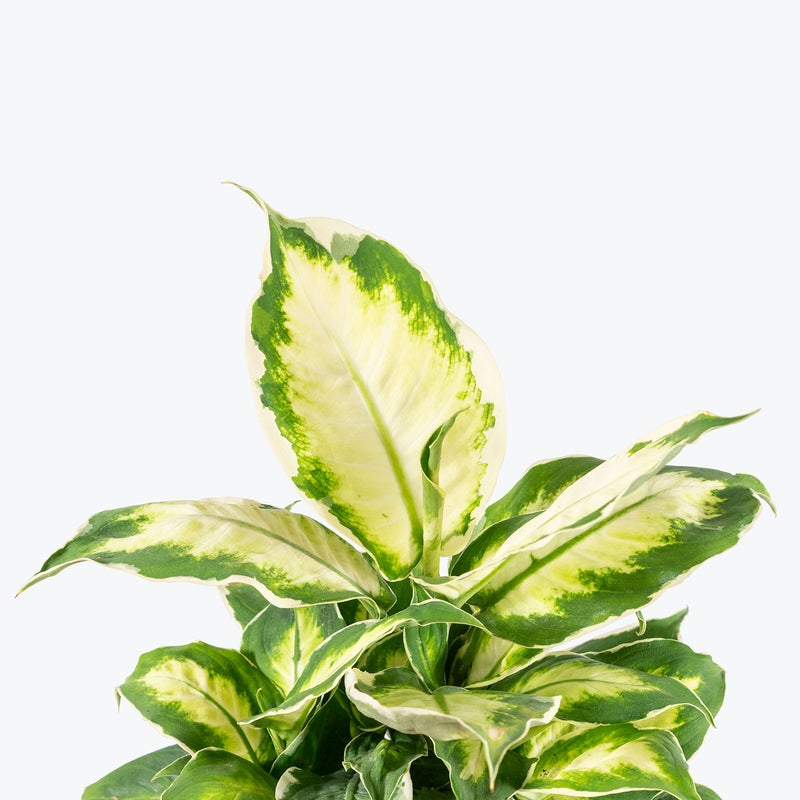
How to care for Dieffenbachia Cool Beauty
Dieffenbachia Cool Beauty should not be in a position to see the sun directly, although early morning or late evening sun is fine. Filtered sunlight through a sheer curtain is best and most homes are comprised primarily of indirect sunlight. The best spot for them is where they do not see the sun during the majority of the day but still get bright, indirect light.
Dieffenbachia Cool Beauty will thrive in bright light, but also can tolerate medium light. A good medium-light place in your home would be in the middle of a room that has a regular size window. They can be placed anywhere between the middle of the room and the window. Remember that plants will grow based on how much light they receive.
Dieffenbachia Cool Beauty needs to be watered when the top half of the soil is dry to the touch. That usually takes about 1 week in an average home environment. It will vary depending on the time of year, your environment and lighting conditions, but it's always safer to underwater or give the soil a check before you water again.
Dieffenbachia Cool Beauty will do well in average humidity environments but will appreciate a little bit of humidity if provided, give them a mist daily or get a humidifier!
Fertilize Dieffenbachia Cool Beauty every four to six weeks during the growing season with a balanced, water-soluble fertilizer diluted to half strength. Prune any yellowing or damaged leaves to keep the plant looking tidy and healthy. Rotate the plant periodically to ensure even growth on all sides.
Dieffenbachia Cool Beauty is moderately toxic and can cause some adverse reactions when ingested so it is best to not let your pets eat it, which we advise for all plants in general. The severity of the reaction will depend on how much of the plant is ingested but, if you know your pet typically does not eat your plants, this plant will be suitable for your home..
Learn MoreView PlantDieffenbachia Crocodile

How to care for Dieffenbachia Crocodile
They should not be in a position to see the sun directly, although early morning or late evening sun is fine. Filtered sunlight through a sheer curtain is best and most homes are comprised primarily of indirect sunlight. The best spot for them is where they do not see the sun during the majority of the day but still get bright, indirect light.
They will do well in medium light but will grow faster with brighter light. A good medium-light place in your home would be in the middle of a room that has a regular size window. Remember that plants will grow based on how much light they receive.
They need to be watered when the top half of the soil is dry to the touch. That usually takes about 1 week in an average home environment. It will vary depending on the time of year, your environment and lighting conditions, but it's always safer to underwater or give the soil a check before you water again.
They will do well in average humidity environments but will appreciate a little bit of humidity if provided, give them a mist daily or get a humidifier!
Wipe the leaves with a damp cloth to remove dust and to allow the plant to breathe more easily. Also, repot every 2-3 years to give its roots room to expand.
This plant is moderately toxic and can cause some adverse reactions when ingested so it is best to not let your pets eat it, which we advise for all plants in general. The severity of the reaction will depend on how much of the plant is ingested but, if you know your pet typically does not eat your plants, this plant will be suitable for your home..
Learn MoreView PlantDieffenbachia Memoria Corsii
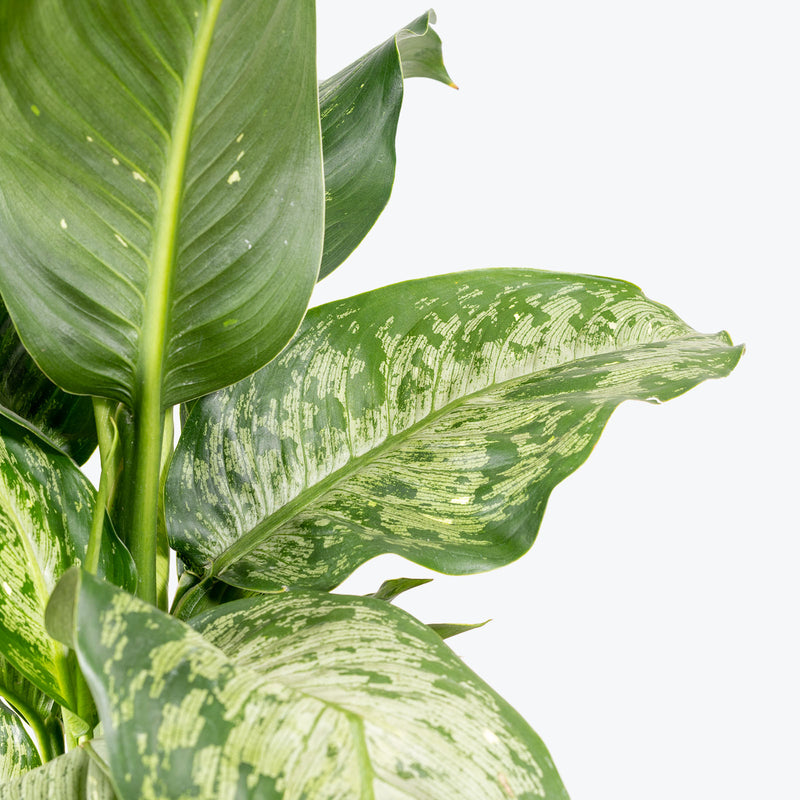
How to care for Dieffenbachia Memoria Corsii
Dieffenbachia Memoria Corsii should not be in a position to see the sun directly, although early morning or late evening sun is fine. Filtered sunlight through a sheer curtain is best and most homes are comprised primarily of indirect sunlight. The best spot for them is where they do not see the sun during the majority of the day but still get bright, indirect light.
Dieffenbachia Memoria Corsii will do well in medium light but will grow faster with brighter light. A good medium-light place in your home would be in the middle of a room that has a regular size window. Remember that plants will grow based on how much light they receive.
Dieffenbachia Memoria Corsii needs to be watered when the top half of the soil is dry to the touch. That usually takes about 1 week in an average home environment. It will vary depending on the time of year, your environment and lighting conditions, but it's always safer to underwater or give the soil a check before you water again.
Dieffenbachia Memoria Corsii will do well in average humidity environments but will appreciate a little bit of humidity if provided, give them a mist daily or get a humidifier!
Rotate Dieffenbachia Memoria Corsii regularly for even growth and prevent it from leaning toward the light. Use a well-draining potting mix and avoid letting it sit in standing water, as Dieffenbachias are sensitive to overwatering. Clean the leaves occasionally to enhance their natural shine and variegation. Fertilize monthly during spring and summer with a diluted, balanced fertilizer to support foliage development.
Dieffenbachia Memoria Corsii is moderately toxic and can cause some adverse reactions when ingested so it is best to not let your pets eat it, which we advise for all plants in general. The severity of the reaction will depend on how much of the plant is ingested but, if you know your pet typically does not eat your plants, this plant will be suitable for your home..
Learn MoreView PlantDieffenbachia Panther

How to care for Dieffenbachia Panther
They should not be in a position to see the sun directly, although early morning or late evening sun is fine. Filtered sunlight through a sheer curtain is best and most homes are comprised primarily of indirect sunlight. The best spot for them is where they do not see the sun during the majority of the day but still get bright, indirect light.
They will do well in medium light but will grow faster with brighter light. A good medium-light place in your home would be in the middle of a room that has a regular size window. Remember that plants will grow based on how much light they receive.
They need to be watered when the top half of the soil is dry to the touch. That usually takes about 1 week in an average home environment. It will vary depending on the time of year, your environment and lighting conditions, but it's always safer to underwater or give the soil a check before you water again.
They will do well in average humidity environments but will appreciate a little bit of humidity if provided, give them a mist daily or get a humidifier!
If you mist it once a week or so it will really help the health of the leaves. Or let it steam in the bathroom once in a while as you relax.
This plant is moderately toxic and can cause some adverse reactions when ingested so it is best to not let your pets eat it, which we advise for all plants in general. The severity of the reaction will depend on how much of the plant is ingested but, if you know your pet typically does not eat your plants, this plant will be suitable for your home..
Learn MoreView PlantDieffenbachia Puerto Rico Variegated

How to care for Dieffenbachia Puerto Rico Variegated
Dieffenbachia Puerto Rico Variegated should not be in a position to see the sun directly, although early morning or late evening sun is fine. Filtered sunlight through a sheer curtain is best and most homes are comprised primarily of indirect sunlight. The best spot for them is where they do not see the sun during the majority of the day but still get bright, indirect light.
Dieffenbachia Puerto Rico Variegated will do well in medium light but will grow faster with brighter light. A good medium-light place in your home would be in the middle of a room that has a regular size window. Remember that plants will grow based on how much light they receive.
Dieffenbachia Puerto Rico Variegated needs to be watered when the top half of the soil is dry to the touch. That usually takes about 1 week in an average home environment. It will vary depending on the time of year, your environment and lighting conditions, but it's always safer to underwater or give the soil a check before you water again.
Dieffenbachia Puerto Rico Variegated will do well in average humidity environments but will appreciate a little bit of humidity if provided, give them a mist daily or get a humidifier!
If you mist Dieffenbachia Puerto Rico Variegated once a week or so it will really help the health of the leaves. Or let it steam in the bathroom once in a while as you relax. Regularly clean the leaves with a damp cloth to remove dust and support efficient photosynthesis. Pruning is not typically necessary but can be used to control size or remove unhealthy leaves.
Dieffenbachia Puerto Rico Variegated is moderately toxic and can cause some adverse reactions when ingested so it is best to not let your pets eat it, which we advise for all plants in general. The severity of the reaction will depend on how much of the plant is ingested but, if you know your pet typically does not eat your plants, this plant will be suitable for your home..
Learn MoreView PlantDieffenbachia Reflector

How to care for Dieffenbachia Reflector
Dieffenbachia Reflector should not be in a position to see the sun directly, although early morning or late evening sun is fine. Filtered sunlight through a sheer curtain is best and most homes are comprised primarily of indirect sunlight. The best spot for them is where they do not see the sun during the majority of the day but still get bright, indirect light.
Dieffenbachia Reflector will do well in medium light but will grow faster with brighter light. A good medium-light place in your home would be in the middle of a room that has a regular size window. Remember that plants will grow based on how much light they receive.
Dieffenbachia Reflector needs to be watered when the top half of the soil is dry to the touch. That usually takes about 1 week in an average home environment. It will vary depending on the time of year, your environment and lighting conditions, but it's always safer to underwater or give the soil a check before you water again.
Dieffenbachia Reflector will do well in average humidity environments but will appreciate a little bit of humidity if provided, give them a mist daily or get a humidifier!
Fertilize Dieffenbachia Reflector with a balanced liquid houseplant fertilizer every month during the growing season (spring and summer). Reduce fertilization during the fall and winter months. Clean the leaves regularly with a damp cloth to remove dust and enhance their natural sheen. If you mist it once a week or so it will really help the health of the leaves. Or let it steam in the bathroom once in a while as you relax.
Dieffenbachia Reflector is moderately toxic and can cause some adverse reactions when ingested so it is best to not let your pets eat it, which we advise for all plants in general. The severity of the reaction will depend on how much of the plant is ingested but, if you know your pet typically does not eat your plants, this plant will be suitable for your home..
Learn MoreView PlantDieffenbachia Rudolph
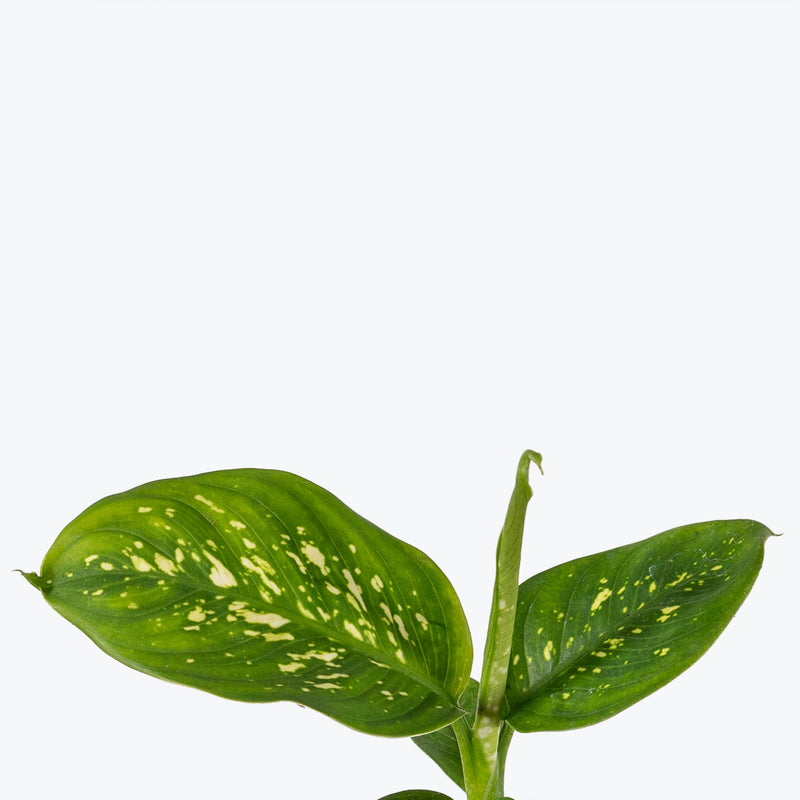
How to care for Dieffenbachia Rudolph
They should not be in a position to see the sun directly, although early morning or late evening sun is fine. Filtered sunlight through a sheer curtain is best and most homes are comprised primarily of indirect sunlight. The best spot for them is where they do not see the sun during the majority of the day but still get bright, indirect light.
They will do well in medium light but will grow faster with brighter light. A good medium-light place in your home would be in the middle of a room that has a regular size window. Remember that plants will grow based on how much light they receive.
They need to be watered when the top half of the soil is dry to the touch. That usually takes about 1 week in an average home environment. It will vary depending on the time of year, your environment and lighting conditions, but it's always safer to underwater or give the soil a check before you water again.
They will do well in average humidity environments but will appreciate a little bit of humidity if provided, give them a mist daily or get a humidifier!
To maintain the plant's vibrant leaf coloration and remove dust, wipe the leaves down occasionally with a soft, damp cloth. Always use gloves when handling this plant, as its sap can be irritating to the skin.
This plant is moderately toxic and can cause some adverse reactions when ingested so it is best to not let your pets eat it, which we advise for all plants in general. The severity of the reaction will depend on how much of the plant is ingested but, if you know your pet typically does not eat your plants, this plant will be suitable for your home..
Learn MoreView PlantDieffenbachia Star Bright
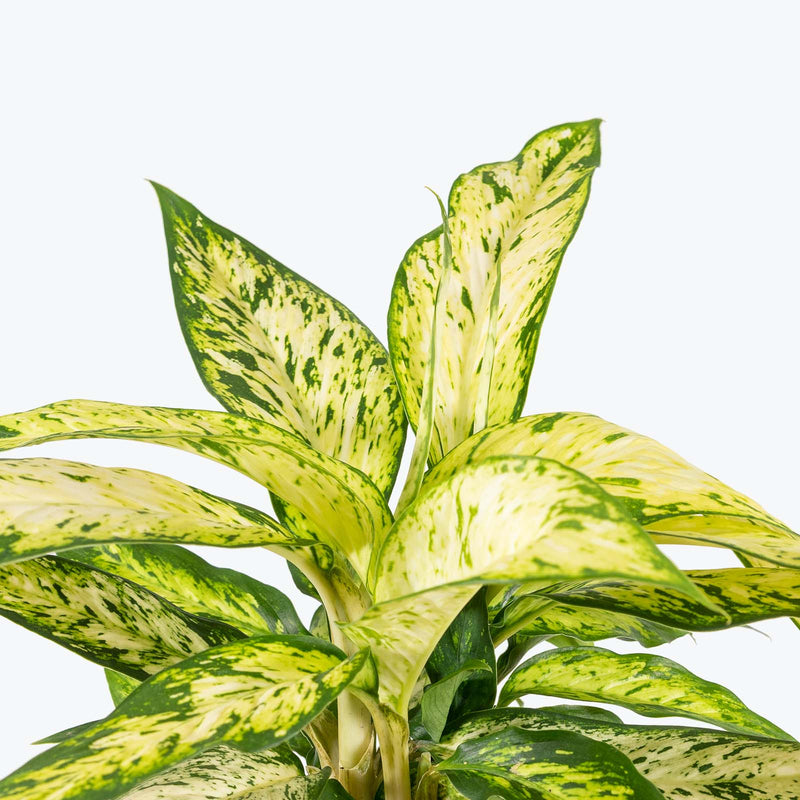
How to care for Dieffenbachia Star Bright
They should not be in a position to see the sun directly, although early morning or late evening sun is fine. Filtered sunlight through a sheer curtain is best and most homes are comprised primarily of indirect sunlight. The best spot for them is where they do not see the sun during the majority of the day but still get bright, indirect light.
They will do well in medium light but will grow faster with brighter light. A good medium-light place in your home would be in the middle of a room that has a regular size window. Remember that plants will grow based on how much light they receive.
They need to be watered when the top half of the soil is dry to the touch. That usually takes about 1 week in an average home environment. It will vary depending on the time of year, your environment and lighting conditions, but it's always safer to underwater or give the soil a check before you water again.
They will do well in average humidity environments but will appreciate a little bit of humidity if provided, give them a mist daily or get a humidifier!
Fertilize with a balanced liquid fertilizer every 4-6 weeks during the growing season. Regularly dusting or wiping the leaves can help the plant breathe better and also accentuates its beautiful variegation. If any leaves start yellowing or browning, prune them to encourage new, healthy growth.
This plant is moderately toxic and can cause some adverse reactions when ingested so it is best to not let your pets eat it, which we advise for all plants in general. The severity of the reaction will depend on how much of the plant is ingested but, if you know your pet typically does not eat your plants, this plant will be suitable for your home..
Learn MoreView PlantDieffenbachia Sterling
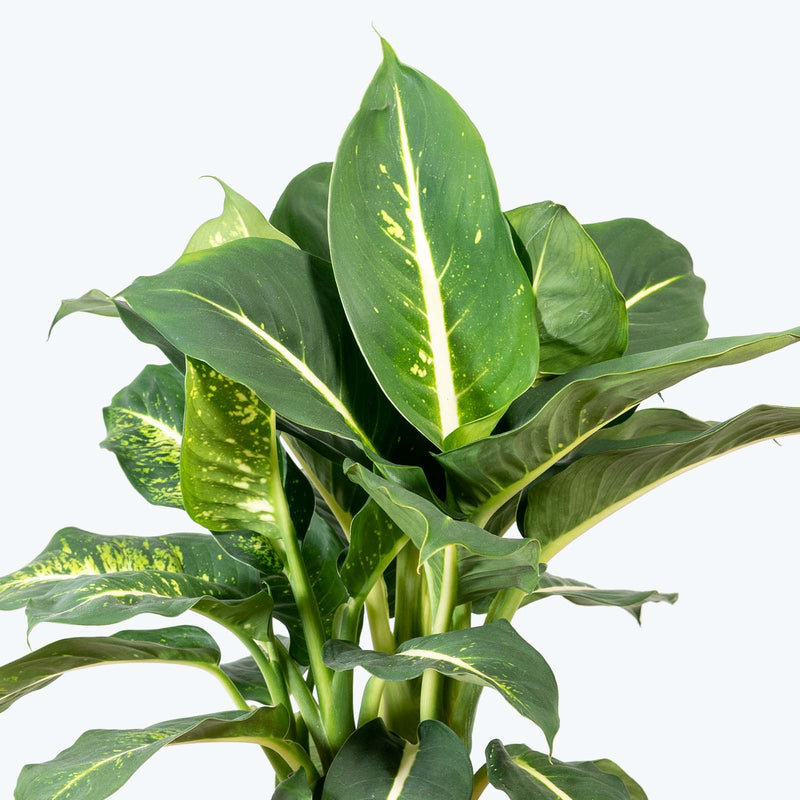
How to care for Dieffenbachia Sterling
They should not be in a position to see the sun directly, although early morning or late evening sun is fine. Filtered sunlight through a sheer curtain is best and most homes are comprised primarily of indirect sunlight. The best spot for them is where they do not see the sun during the majority of the day but still get bright, indirect light.
They will do well in medium light but will grow faster with brighter light. A good medium-light place in your home would be in the middle of a room that has a regular size window. Remember that plants will grow based on how much light they receive.
They need to be watered when the top half of the soil is dry to the touch. That usually takes about 1 week in an average home environment. It will vary depending on the time of year, your environment and lighting conditions, but it's always safer to underwater or give the soil a check before you water again.
They will do well in average humidity environments but will appreciate a little bit of humidity if provided, give them a mist daily or get a humidifier!
If you mist it once a week or so it will really help the health of the leaves. Or let it steam in the bathroom once in a while as you relax.
This plant is moderately toxic and can cause some adverse reactions when ingested so it is best to not let your pets eat it, which we advise for all plants in general. The severity of the reaction will depend on how much of the plant is ingested but, if you know your pet typically does not eat your plants, this plant will be suitable for your home..
Learn MoreView PlantDieffenbachia Tiki
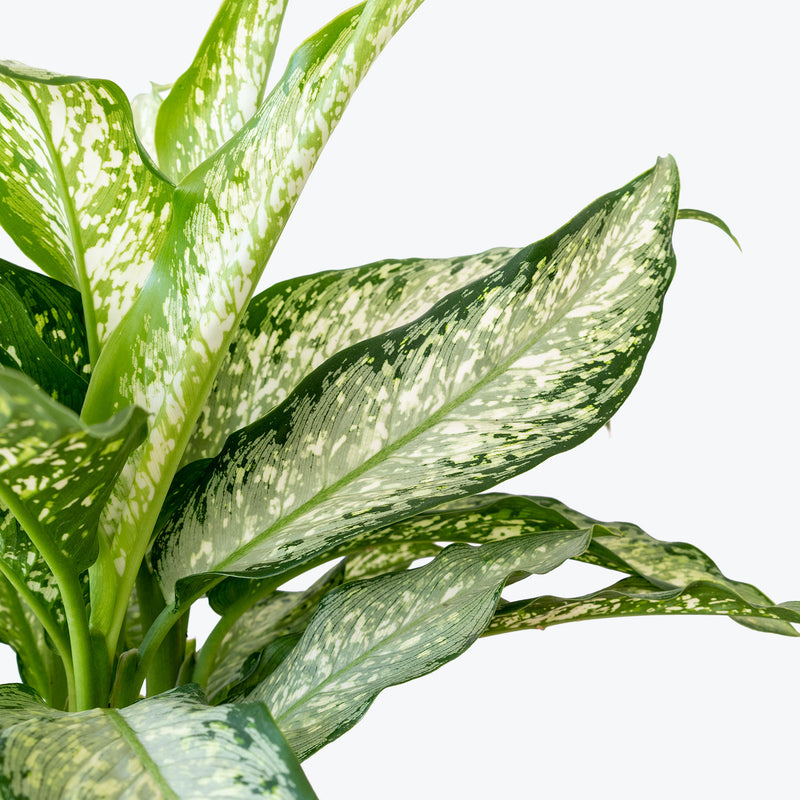
How to care for Dieffenbachia Tiki
They should not be in a position to see the sun directly, although early morning or late evening sun is fine. Filtered sunlight through a sheer curtain is best and most homes are comprised primarily of indirect sunlight. The best spot for them is where they do not see the sun during the majority of the day but still get bright, indirect light.
They will do well in medium light but will grow faster with brighter light. A good medium-light place in your home would be in the middle of a room that has a regular size window. Remember that plants will grow based on how much light they receive.
They need to be watered when the top half of the soil is dry to the touch. That usually takes about 1 week in an average home environment. It will vary depending on the time of year, your environment and lighting conditions, but it's always safer to underwater or give the soil a check before you water again.
They will do well in average humidity environments but will appreciate a little bit of humidity if provided, give them a mist daily or get a humidifier!
If you mist it once a week or so it will really help the health of the leaves. Or let it steam in the bathroom once in a while as you relax.
This plant is moderately toxic and can cause some adverse reactions when ingested so it is best to not let your pets eat it, which we advise for all plants in general. The severity of the reaction will depend on how much of the plant is ingested but, if you know your pet typically does not eat your plants, this plant will be suitable for your home..
Learn MoreView PlantDieffenbachia Tropic Marianne
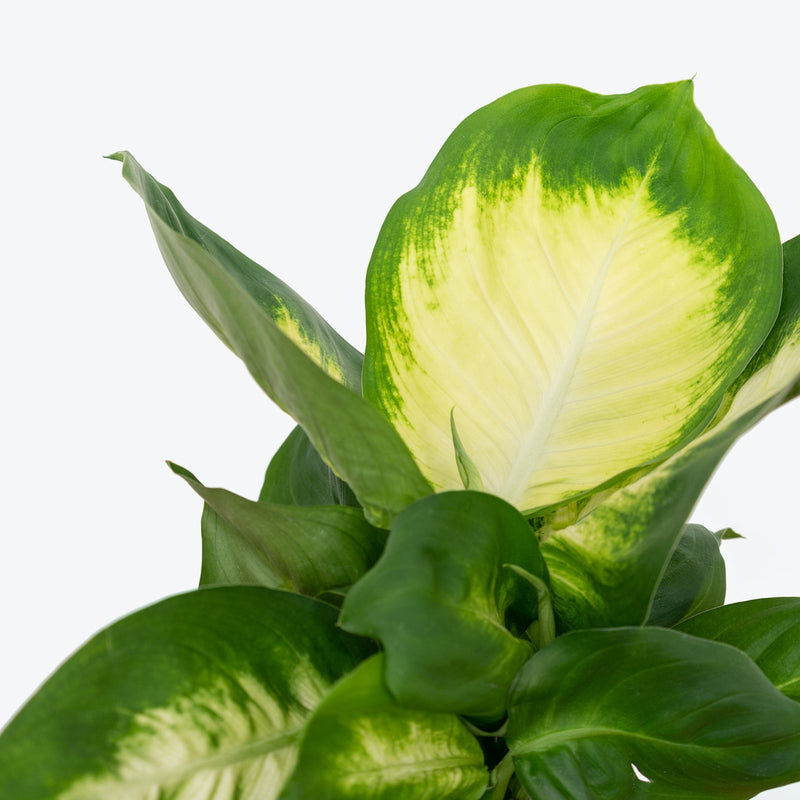
How to care for Dieffenbachia Tropic Marianne
Dieffenbachia Tropic Marianne should not be in a position to see the sun directly, although early morning or late evening sun is fine. Filtered sunlight through a sheer curtain is best and most homes are comprised primarily of indirect sunlight. The best spot for them is where they do not see the sun during the majority of the day but still get bright, indirect light.
Dieffenbachia Tropic Marianne will do well in medium light but will grow faster with brighter light. A good medium-light place in your home would be in the middle of a room that has a regular size window. Remember that plants will grow based on how much light they receive.
Dieffenbachia Tropic Marianne needs to be watered when the top half of the soil is dry to the touch. That usually takes about 1 week in an average home environment. It will vary depending on the time of year, your environment and lighting conditions, but it's always safer to underwater or give the soil a check before you water again.
Dieffenbachia Tropic Marianne will do well in average humidity environments but will appreciate a little bit of humidity if provided, give them a mist daily or get a humidifier!
Prune any damaged or old leaves to encourage new growth and maintain a bushy appearance. Wipe the leaves with a damp cloth occasionally to remove dust. If you mist Dieffenbachia Tropic Marianne once a week or so it will really help the health of the leaves. Or let it steam in the bathroom once in a while as you relax.
Dieffenbachia Tropic Marianne is moderately toxic and can cause some adverse reactions when ingested so it is best to not let your pets eat it, which we advise for all plants in general. The severity of the reaction will depend on how much of the plant is ingested but, if you know your pet typically does not eat your plants, this plant will be suitable for your home..
Learn MoreView PlantDieffenbachia Tropic Snow
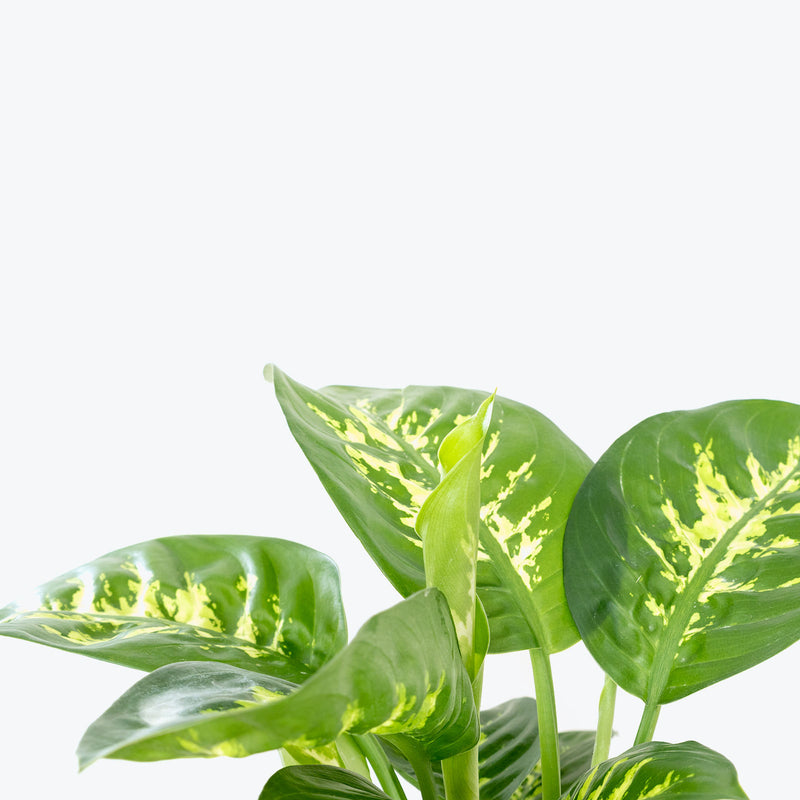
How to care for Dieffenbachia Tropic Snow
They should not be in a position to see the sun directly, although early morning or late evening sun is fine. Filtered sunlight through a sheer curtain is best and most homes are comprised primarily of indirect sunlight. The best spot for them is where they do not see the sun during the majority of the day but still get bright, indirect light.
They will do well in medium light but will grow faster with brighter light. A good medium-light place in your home would be in the middle of a room that has a regular size window. Remember that plants will grow based on how much light they receive.
They need to be watered when the top half of the soil is dry to the touch. That usually takes about 1 week in an average home environment. It will vary depending on the time of year, your environment and lighting conditions, but it's always safer to underwater or give the soil a check before you water again.
They will do well in average humidity environments but will appreciate a little bit of humidity if provided, give them a mist daily or get a humidifier!
If you mist it once a week or so it will really help the health of the leaves. Or let it steam in the bathroom once in a while as you relax.
This plant is moderately toxic and can cause some adverse reactions when ingested so it is best to not let your pets eat it, which we advise for all plants in general. The severity of the reaction will depend on how much of the plant is ingested but, if you know your pet typically does not eat your plants, this plant will be suitable for your home..
Learn MoreView PlantDieffenbachia Vesuvius

How to care for Dieffenbachia Vesuvius
Dieffenbachia Vesuvius should not be in a position to see the sun directly, although early morning or late evening sun is fine. Filtered sunlight through a sheer curtain is best and most homes are comprised primarily of indirect sunlight. The best spot for them is where they do not see the sun during the majority of the day but still get bright, indirect light.
Dieffenbachia Vesuvius will thrive in bright light, but also can tolerate medium light. A good medium-light place in your home would be in the middle of a room that has a regular size window. They can be placed anywhere between the middle of the room and the window. Remember that plants will grow based on how much light they receive.
Dieffenbachia Vesuvius needs to be watered when the top half of the soil is dry to the touch. That usually takes about 1 week in an average home environment. It will vary depending on the time of year, your environment and lighting conditions, but it's always safer to underwater or give the soil a check before you water again.
Dieffenbachia Vesuvius will do well in average humidity environments but will appreciate a little bit of humidity if provided, give them a mist daily or get a humidifier!
Use a well-draining potting mix and keep away from drafts or sudden temperature changes. Rotate Dieffenbachia Vesuvius regularly to maintain even growth. Fertilize monthly during the growing season with a diluted balanced fertilizer. Wipe the leaves occasionally to highlight their vibrant patterns.
Dieffenbachia Vesuvius is moderately toxic and can cause some adverse reactions when ingested so it is best to not let your pets eat it, which we advise for all plants in general. The severity of the reaction will depend on how much of the plant is ingested but, if you know your pet typically does not eat your plants, this plant will be suitable for your home..
Learn MoreView PlantDieffenbachia White Etna
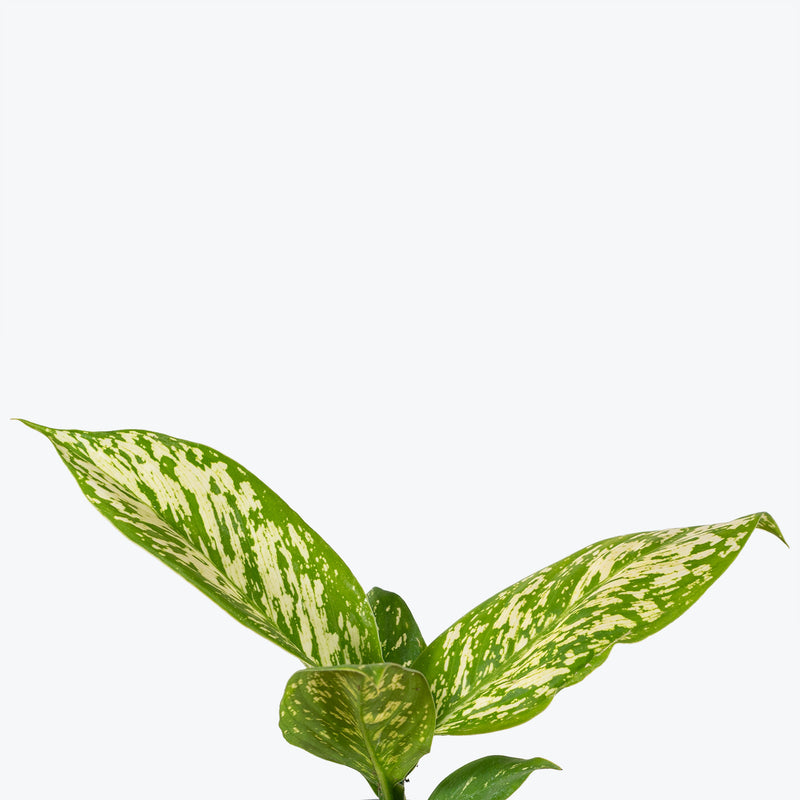
How to care for Dieffenbachia White Etna
They should not be in a position to see the sun directly, although early morning or late evening sun is fine. Filtered sunlight through a sheer curtain is best and most homes are comprised primarily of indirect sunlight. The best spot for them is where they do not see the sun during the majority of the day but still get bright, indirect light.
They will thrive in bright light, but also can tolerate medium light. A good medium-light place in your home would be in the middle of a room that has a regular size window. They can be placed anywhere between the middle of the room and the window. Remember that plants will grow based on how much light they receive.
They need to be watered when the top half of the soil is dry to the touch. That usually takes about 1 week in an average home environment. It will vary depending on the time of year, your environment and lighting conditions, but it's always safer to underwater or give the soil a check before you water again.
They will do well in average humidity environments but will appreciate a little bit of humidity if provided, give them a mist daily or get a humidifier!
Wipe the leaves with a damp cloth regularly to remove dust and help prevent pest infestations. If the plant becomes too tall or leggy, you can prune the top to encourage bushier growth. Use gloves when handling Dieffenbachia, as the sap can be irritating to the skin and mucous membranes.
This plant is moderately toxic and can cause some adverse reactions when ingested so it is best to not let your pets eat it, which we advise for all plants in general. The severity of the reaction will depend on how much of the plant is ingested but, if you know your pet typically does not eat your plants, this plant will be suitable for your home..
Learn MoreView PlantDipladenia
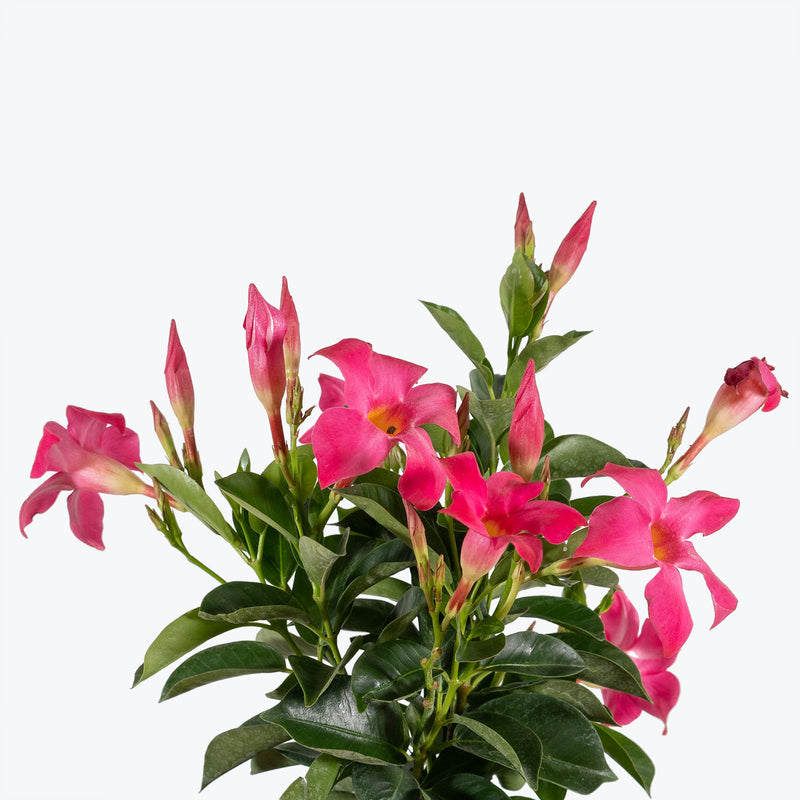
How to care for Dipladenia
They love as much heat and sun as possible. The best spot for them is where they can see the sun for the majority of the day.
They will do their best and flower profusely in bright light. A nice bright place outside would be on a sunny balcony, deck, or backyard; inside your home, it would do best in a sunny window sill. Remember that plants will grow and flower based on how much light they receive.
They need to be watered when the top half of the soil is dry to the touch. When outside, how fast the soil dries will depend on how sunny and warm the days are, so check your plant daily. Indoors, that can take about 1 week, but it will vary depending on the time of year, the environment, and lighting conditions. It's safer to underwater, or check the soil, before you water again, especially during the winter. Expect to water more often in the summer and less often in the winter.
They like a high humidity environment. Outdoors, this should happen naturally in the summer, but indoors, give them a mist daily or as often as possible. Alternatively, you can put them around a humidifier. Although they won't die if they don't receive enough humidity, their leaves may have some dry, crunchy, or yellow edges.
In order for them to bloom steadily, they truly need 6-8 hours of direct sunlight. Their stunning flowers will add pops of colour to your home, balcony, or yard. Fertilize every 2 weeks in the growing season with diluted, liquid fertilizer. Since they are relatively drought-tolerant, they are a great pick for busy or forgetful gardeners who may forget to water from time to time. To overwinter your plant, bring them inside and keep them in a window that receives sun all day, only watering when the top half of the soil is dry. Some foliage may die but they should produce new foliage in the Spring again.
This plant is moderately toxic and can cause some adverse reactions when ingested so it is best to not let your pets eat it, which we advise for all plants in general. The severity of the reaction will depend on how much of the plant is ingested but, if you know your pet typically does not eat your plants, this plant will be suitable for your home..
View PlantDischidia Million Hearts

How to care for Dischidia Million Hearts
They should not be in a position to see the sun directly, although early morning or late evening sun is fine. Filtered sunlight through a sheer curtain is best and most homes are comprised primarily of indirect sunlight. The best spot for them is where they do not see the sun during the majority of the day but still get bright, indirect light.
They will do best in bright light. A nice bright place inside your home would be on the window sill or a stool that is right next to a window, either with or without blinds, depending on if the plant can handle sun. Remember that plants will grow based on how much light they receive.
They like the soil to be completely dry before the next watering. That usually takes about 4 weeks in an average home environment. It will vary depending on the time of year, your environment and lighting conditions, but for them, it's always safer to underwater or water when you see signs of lack of water (i.e. wrinkly or soft leaves).
They can live in any average home humidity condition and are fairly hardy.
Water thoroughly but allow the soil to dry slightly between waterings, when the leaves are slightly wrinkled and puckered, it is time to water. Prune the plant to maintain size.
This plant is moderately toxic and can cause some adverse reactions when ingested so it is best to not let your pets eat it, which we advise for all plants in general. The severity of the reaction will depend on how much of the plant is ingested but, if you know your pet typically does not eat your plants, this plant will be suitable for your home..
View PlantDischidia Oiantha Variegata
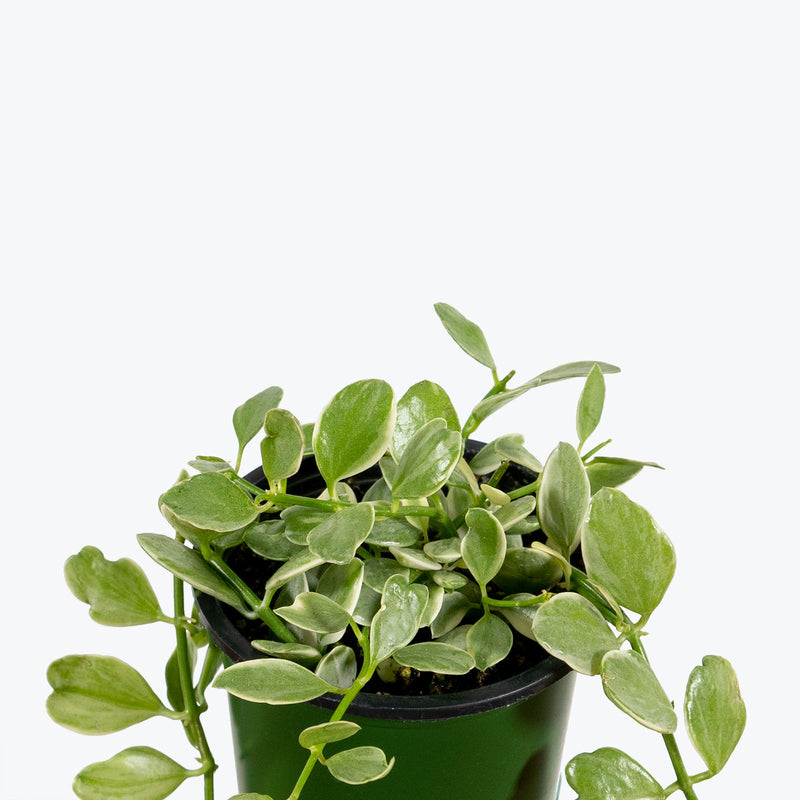
How to care for Dischidia Oiantha Variegata
They should not be in a position to see the sun directly, although early morning or late evening sun is fine. Filtered sunlight through a sheer curtain is best and most homes are comprised primarily of indirect sunlight. The best spot for them is where they do not see the sun during the majority of the day but still get bright, indirect light.
They will thrive in bright light, but also can tolerate medium light. A good medium-light place in your home would be in the middle of a room that has a regular size window. They can be placed anywhere between the middle of the room and the window. Remember that plants will grow based on how much light they receive.
They need to be watered when the top half of the soil is dry to the touch. That usually takes about 1 week in an average home environment. It will vary depending on the time of year, your environment and lighting conditions, but it's always safer to underwater or give the soil a check before you water again. Expect to water more often in brighter light and less often in lower light.
They like a high humidity environment, give them a mist daily or as often as possible. Alternatively, you can put them around a humidifier. Although they won't die if they don't receive enough humidity, their leaves may have some dry, crunchy, or yellow edges.
Dischidia are very closely related to their sister genus of Hoya, so this is something to consider when you are caring for your plant. If possible, try to keep the potting mix for your Dischidia light and airy.
This plant is moderately toxic and can cause some adverse reactions when ingested so it is best to not let your pets eat it, which we advise for all plants in general. The severity of the reaction will depend on how much of the plant is ingested but, if you know your pet typically does not eat your plants, this plant will be suitable for your home..
View PlantDischidia Ovata Watermelon

How to care for Dischidia Ovata Watermelon
Dischidia Ovata Watermelon should not be in a position to see the sun directly, although early morning or late evening sun is fine. Filtered sunlight through a sheer curtain is best and most homes are comprised primarily of indirect sunlight. The best spot for them is where they do not see the sun during the majority of the day but still get bright, indirect light.
Dischidia Ovata Watermelon will thrive in bright light, but also can tolerate medium light. A good medium-light place in your home would be in the middle of a room that has a regular size window. They can be placed anywhere between the middle of the room and the window. Remember that plants will grow based on how much light they receive.
Dischidia Ovata Watermelon needs to be watered when the top half of the soil is dry to the touch. That usually takes about 1 week in an average home environment. It will vary depending on the time of year, your environment and lighting conditions, but it's always safer to underwater or give the soil a check before you water again. Expect to water more often in brighter light and less often in lower light.
Dischidia Ovata Watermelon likes a high humidity environment, give them a mist daily or as often as possible. Alternatively, you can put them around a humidifier. Although they won't die if they don't receive enough humidity, their leaves may have some dry, crunchy, or yellow edges.
Dischidia are very closely related to their sister genus of Hoya, so this is something to consider when you are caring for your plant. Fertilize Dischidia Ovata Watermelon lightly with a balanced liquid fertilizer diluted to half strength every 4-6 weeks during the growing season. During the winter months, reduce fertilization. Pruning can be done to maintain the desired shape and remove any yellow or dead leaves. Support its trailing habit with a trellis or allow it to hang naturally from a basket.
You can feel comfortable having Dischidia Ovata Watermelon around your home in the potential case where your pet feels like nibbling on it. However, we typically recommend keeping your pets from eating any of your houseplants..
View PlantDracaena Fragrans Massangeana
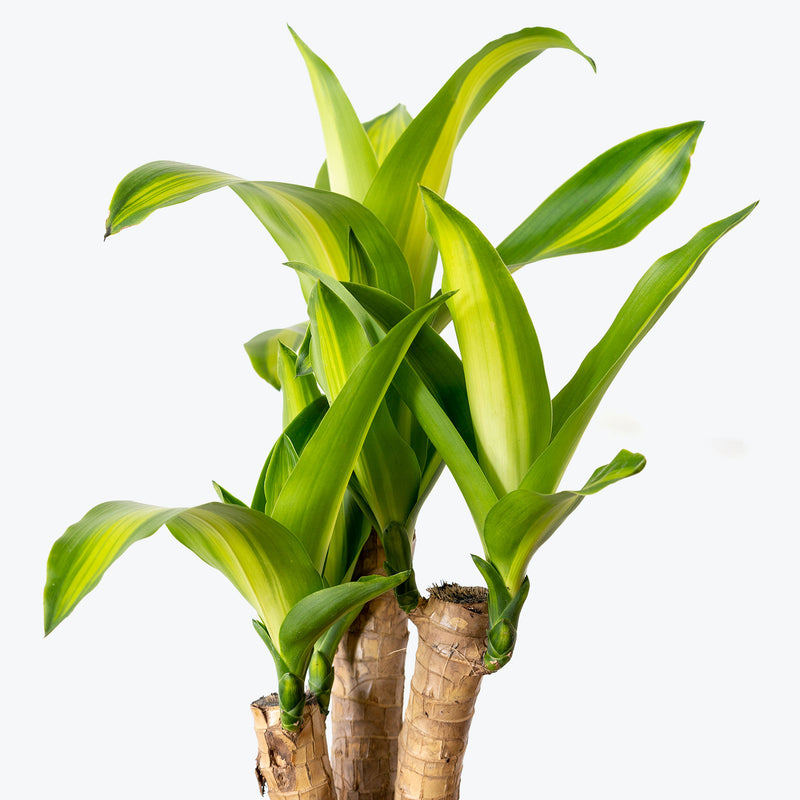
How to care for Dracaena Fragrans Massangeana
Dracaena Fragrans Massangeana should not be in a position to see the sun directly, although early morning or late evening sun is fine. Filtered sunlight through a sheer curtain is best and most homes are comprised primarily of indirect sunlight. The best spot for them is where they do not see the sun during the majority of the day but still get bright, indirect light.
Dracaena Fragrans Massangeana will thrive in medium to bright light, but also can tolerate low light. A good medium-light place in your home would be in the middle of a room that has a regular size window. They can be placed almost anywhere in the room but remember, plants will grow based on how much light they receive.
Dracaena Fragrans Massangeana likes the soil to be relatively dry before the next watering. That usually takes about 2 weeks in an average home environment. It will vary depending on the time of year, your environment and lighting conditions, but for them, it's always safer to underwater or water when you see signs of lack of water (i.e. droopy, floppy, or soft leaves). Water more often in the warmer months.
Dracaena Fragrans Massangeana will do well in average humidity environments but will appreciate a little bit of humidity if provided, give them a mist daily or get a humidifier!
Prune the Dracaena Fragrans Massangeana as needed to control its height and encourage fuller growth. Dust the leaves regularly to ensure the plant can photosynthesize efficiently. Avoid allowing the soil to dry completely. Be sure to water slowly near the base of the plant as Dracaena have shallow roots. Place your plant away from hot or cold air drafts.
Dracaena Fragrans Massangeana is moderately toxic and can cause some adverse reactions when ingested so it is best to not let your pets eat it, which we advise for all plants in general. The severity of the reaction will depend on how much of the plant is ingested but, if you know your pet typically does not eat your plants, this plant will be suitable for your home..
View PlantDracaena Giganta

How to care for Dracaena Giganta
They should not be in a position to see the sun directly, although early morning or late evening sun is fine. Filtered sunlight through a sheer curtain is best and most homes are comprised primarily of indirect sunlight. The best spot for them is where they do not see the sun during the majority of the day but still get bright, indirect light.
They will thrive in medium to bright light, but also can tolerate low light. A good medium-light place in your home would be in the middle of a room that has a regular size window. They can be placed almost anywhere in the room but remember, plants will grow based on how much light they receive.
They like the soil to be relatively dry before the next watering. That usually takes about 2 weeks in an average home environment. It will vary depending on the time of year, your environment and lighting conditions, but for them, it's always safer to underwater or water when you see signs of lack of water (i.e. droopy, floppy, or soft leaves). Water more often in the warmer months.
They will do well in average humidity environments but will appreciate a little bit of humidity if provided, give them a mist daily or get a humidifier.
Avoid allowing the soil to dry completely. Be sure to water slowly near the base of the plant as Dracaena have shallow roots. Place your plant away from hot or cold air drafts.
This plant is moderately toxic and can cause some adverse reactions when ingested so it is best to not let your pets eat it, which we advise for all plants in general. The severity of the reaction will depend on how much of the plant is ingested but, if you know your pet typically does not eat your plants, this plant will be suitable for your home..
View PlantDracaena Goldieana
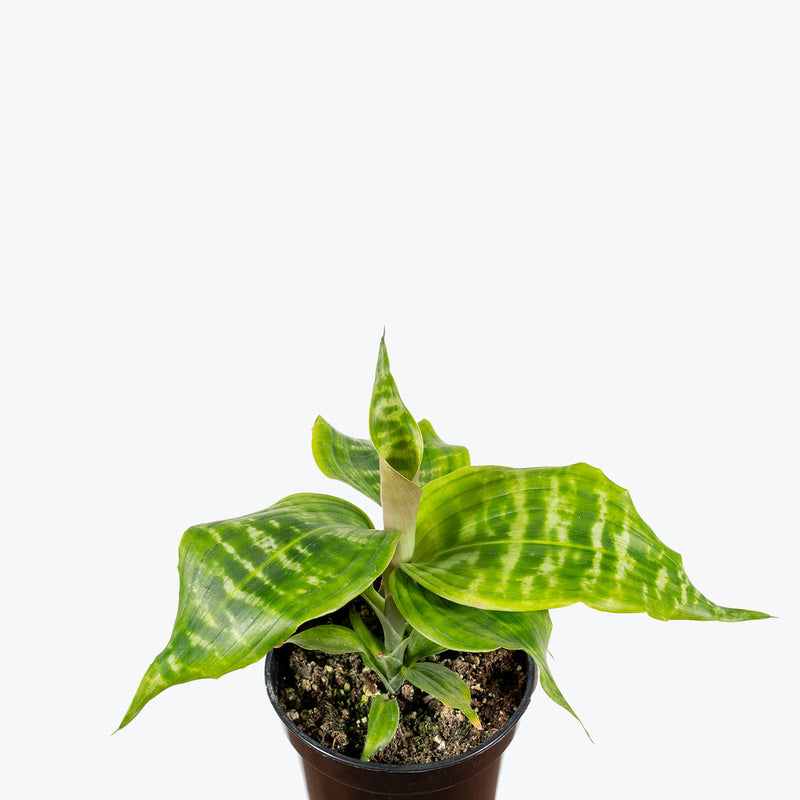
How to care for Dracaena Goldieana
They should not be in a position to see the sun directly, although early morning or late evening sun is fine. Filtered sunlight through a sheer curtain is best and most homes are comprised primarily of indirect sunlight. The best spot for them is where they do not see the sun during the majority of the day but still get bright, indirect light.
They will thrive in medium to bright light, but also can tolerate low light. A good medium-light place in your home would be in the middle of a room that has a regular size window. They can be placed almost anywhere in the room but remember, plants will grow based on how much light they receive.
They like the soil to be relatively dry before the next watering. That usually takes about 2 weeks in an average home environment. It will vary depending on the time of year, your environment and lighting conditions, but for them, it's always safer to underwater or water when you see signs of lack of water (i.e. droopy, floppy, or soft leaves). Expect to water more often in brighter light and less often in lower light.
They will do well in average humidity environments but will appreciate a little bit of humidity if provided, give them a mist daily or get a humidifier.
Avoid allowing the soil to dry completely. Be sure to water slowly near the base of the plant as Dracaena have shallow roots. Place your plant away from hot or cold air drafts.
This plant is moderately toxic and can cause some adverse reactions when ingested so it is best to not let your pets eat it, which we advise for all plants in general. The severity of the reaction will depend on how much of the plant is ingested but, if you know your pet typically does not eat your plants, this plant will be suitable for your home..
View PlantDracaena Jade Jewel

How to care for Dracaena Jade Jewel
They should not be in a position to see the sun directly, although early morning or late evening sun is fine. Filtered sunlight through a sheer curtain is best and most homes are comprised primarily of indirect sunlight. The best spot for them is where they do not see the sun during the majority of the day but still get bright, indirect light.
They will thrive in medium to bright light, but also can tolerate low light. A good medium-light place in your home would be in the middle of a room that has a regular size window. They can be placed almost anywhere in the room but remember, plants will grow based on how much light they receive.
They like the soil to be relatively dry before the next watering. That usually takes about 2 weeks in an average home environment. It will vary depending on the time of year, your environment and lighting conditions, but for them, it's always safer to underwater or water when you see signs of lack of water (i.e. droopy, floppy, or soft leaves). Expect to water more often in brighter light and less often in lower light.
They will do well in average humidity environments but will appreciate a little bit of humidity if provided, give them a mist daily or get a humidifier.
Avoid allowing the soil to dry completely. Be sure to water slowly near the base of the plant as Dracaena have shallow roots. Place your plant away from hot or cold air drafts.
This plant is moderately toxic and can cause some adverse reactions when ingested so it is best to not let your pets eat it, which we advise for all plants in general. The severity of the reaction will depend on how much of the plant is ingested but, if you know your pet typically does not eat your plants, this plant will be suitable for your home..
View PlantDracaena Janet Craig

How to care for Dracaena Janet Craig
They should not be in a position to see the sun directly, although early morning or late evening sun is fine. Filtered sunlight through a sheer curtain is best and most homes are comprised primarily of indirect sunlight. The best spot for them is where they do not see the sun during the majority of the day but still get bright, indirect light.
They will thrive in medium to bright light, but also can tolerate low light. A good medium-light place in your home would be in the middle of a room that has a regular size window. They can be placed almost anywhere in the room but remember, plants will grow based on how much light they receive.
They like the soil to be relatively dry before the next watering. That usually takes about 2 weeks in an average home environment. It will vary depending on the time of year, your environment and lighting conditions, but for them, it's always safer to underwater or water when you see signs of lack of water (i.e. droopy, floppy, or soft leaves). Water more often in the warmer months!
They will do well in average humidity environments but will appreciate a little bit of humidity if provided, give them a mist daily or get a humidifier!
Avoid allowing the soil to dry completely. Be sure to water slowly near the base of the plant as Dracaena have shallow roots. Place your plant away from hot or cold air drafts.
This plant is moderately toxic and can cause some adverse reactions when ingested so it is best to not let your pets eat it, which we advise for all plants in general. The severity of the reaction will depend on how much of the plant is ingested but, if you know your pet typically does not eat your plants, this plant will be suitable for your home..
View PlantDracaena JC Compacta
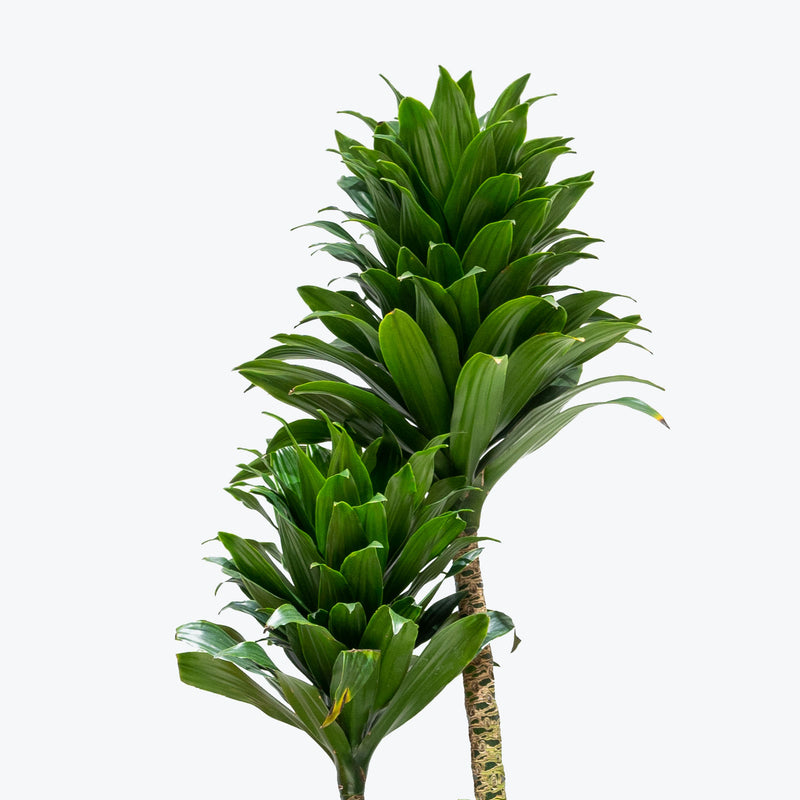
How to care for Dracaena JC Compacta
They should not be in a position to see the sun directly, although early morning or late evening sun is fine. Filtered sunlight through a sheer curtain is best and most homes are comprised primarily of indirect sunlight. The best spot for them is where they do not see the sun during the majority of the day but still get bright, indirect light.
They will thrive in medium to bright light, but also can tolerate low light. A good medium-light place in your home would be in the middle of a room that has a regular size window. They can be placed almost anywhere in the room but remember, plants will grow based on how much light they receive.
They like the soil to be relatively dry before the next watering. That usually takes about 2 weeks in an average home environment. It will vary depending on the time of year, your environment and lighting conditions, but for them, it's always safer to underwater or water when you see signs of lack of water (i.e. droopy, floppy, or soft leaves). Water more often in the warmer months.
They will do well in average humidity environments but will appreciate a little bit of humidity if provided, give them a mist daily or get a humidifier.
Avoid allowing the soil to dry completely. Be sure to water slowly near the base of the plant as Dracaena have shallow roots. Place your plant away from hot or cold air drafts.
This plant is moderately toxic and can cause some adverse reactions when ingested so it is best to not let your pets eat it, which we advise for all plants in general. The severity of the reaction will depend on how much of the plant is ingested but, if you know your pet typically does not eat your plants, this plant will be suitable for your home..
View PlantDracaena Kristi

How to care for Dracaena Kristi
Dracaena Kristi should not be in a position to see the sun directly, although early morning or late evening sun is fine. Filtered sunlight through a sheer curtain is best and most homes are comprised primarily of indirect sunlight. The best spot for them is where they do not see the sun during the majority of the day but still get bright, indirect light.
Dracaena Kristi will thrive in medium to bright light, but also can tolerate low light. A good medium-light place in your home would be in the middle of a room that has a regular size window. They can be placed almost anywhere in the room but remember, plants will grow based on how much light they receive.
Dracaena Kristi likes the soil to be relatively dry before the next watering. That usually takes about 2 weeks in an average home environment. It will vary depending on the time of year, your environment and lighting conditions, but for them, it's always safer to underwater or water when you see signs of lack of water (i.e. droopy, floppy, or soft leaves). Expect to water more often in brighter light and less often in lower light.
Dracaena Kristi will do well in average humidity environments but will appreciate a little bit of humidity if provided, give them a mist daily or get a humidifier.
Avoid allowing the soil to dry completely. Be sure to water slowly near the base of the plant as Dracaena Kristi has shallow roots. Prune back any old or yellowing leaves to encourage new growth and maintain the plant’s appearance. Be cautious with the placement regarding drafts or heat sources, as these can cause stress to the plant.
Dracaena Kristi is moderately toxic and can cause some adverse reactions when ingested so it is best to not let your pets eat it, which we advise for all plants in general. The severity of the reaction will depend on how much of the plant is ingested but, if you know your pet typically does not eat your plants, this plant will be suitable for your home..
View PlantDracaena Lemon Lime

How to care for Dracaena Lemon Lime
Dracaena Lemon Lime should not be in a position to see the sun directly, although early morning or late evening sun is fine. Filtered sunlight through a sheer curtain is best and most homes are comprised primarily of indirect sunlight. The best spot for them is where they do not see the sun during the majority of the day but still get bright, indirect light.
Dracaena Lemon Lime will thrive in medium to bright light, but also can tolerate low light. A good medium-light place in your home would be in the middle of a room that has a regular size window. They can be placed almost anywhere in the room but remember, plants will grow based on how much light they receive.
Dracaena Lemon Lime likes the soil to be relatively dry before the next watering. That usually takes about 2 weeks in an average home environment. It will vary depending on the time of year, your environment and lighting conditions, but for them, it's always safer to underwater or water when you see signs of lack of water (i.e. droopy, floppy, or soft leaves). Expect to water more often in brighter light and less often in lower light.
Dracaena Lemon Lime will do well in average humidity environments but will appreciate a little bit of humidity if provided, give them a mist daily or get a humidifier.
Avoid allowing the soil to dry completely. Be sure to water slowly near the base of the plant as Dracaena has shallow roots. Place Dracaena Lemon Lime away from hot or cold air drafts. Regularly dust the leaves to ensure efficient photosynthesis and inspect them for pests. If the plant becomes too tall, it can be pruned to encourage bushier growth.
Dracaena Lemon Lime is moderately toxic and can cause some adverse reactions when ingested so it is best to not let your pets eat it, which we advise for all plants in general. The severity of the reaction will depend on how much of the plant is ingested but, if you know your pet typically does not eat your plants, this plant will be suitable for your home..
View PlantDracaena Lemon Surprise

How to care for Dracaena Lemon Surprise
Dracaena Lemon Surprise should not be in a position to see the sun directly, although early morning or late evening sun is fine. Filtered sunlight through a sheer curtain is best and most homes are comprised primarily of indirect sunlight. The best spot for them is where they do not see the sun during the majority of the day but still get bright, indirect light.
Dracaena Lemon Surprise will thrive in medium to bright light, but also can tolerate low light. A good medium-light place in your home would be in the middle of a room that has a regular size window. They can be placed almost anywhere in the room but remember, plants will grow based on how much light they receive.
Dracaena Lemon Surprise likes the soil to be relatively dry before the next watering. That usually takes about 2 weeks in an average home environment. It will vary depending on the time of year, your environment and lighting conditions, but for them, it's always safer to underwater or water when you see signs of lack of water (i.e. droopy, floppy, or soft leaves). Expect to water more often in brighter light and less often in lower light.
Dracaena Lemon Surprise will do well in average humidity environments but will appreciate a little bit of humidity if provided, give them a mist daily or get a humidifier.
Fertilize every 6 weeks during the growing season with a balanced liquid fertilizer diluted to half the recommended strength. Clean the leaves regularly with a damp cloth to remove dust and prevent pest infestations. Dracaena Lemon Surprise is relatively slow-growing but can be pruned back if it becomes too tall or leggy.
Dracaena Lemon Surprise is moderately toxic and can cause some adverse reactions when ingested so it is best to not let your pets eat it, which we advise for all plants in general. The severity of the reaction will depend on how much of the plant is ingested but, if you know your pet typically does not eat your plants, this plant will be suitable for your home..
View PlantDracaena Limelight
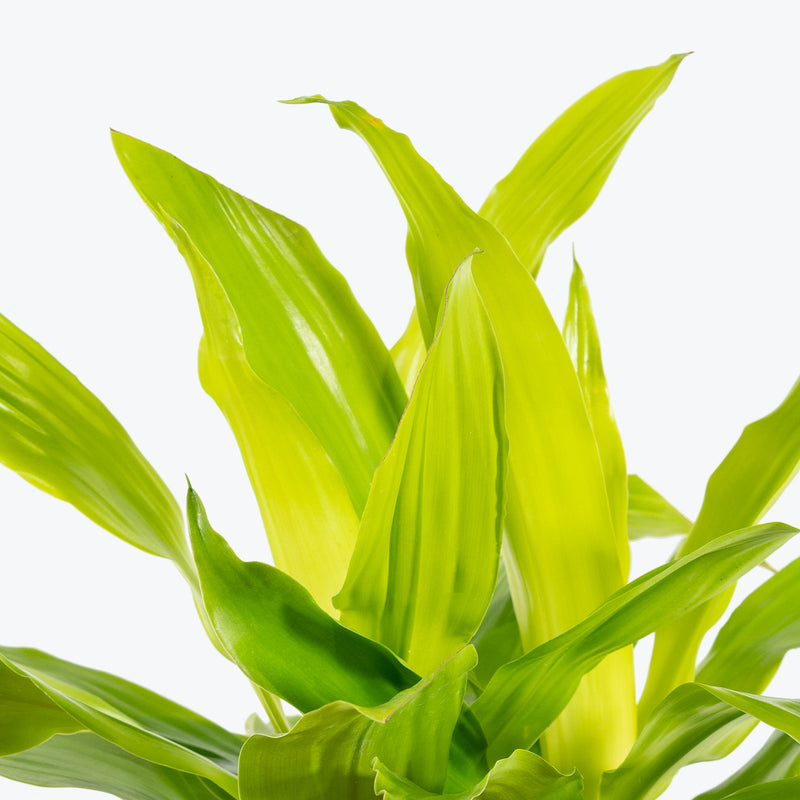
How to care for Dracaena Limelight
They should not be in a position to see the sun directly, although early morning or late evening sun is fine. Filtered sunlight through a sheer curtain is best and most homes are comprised primarily of indirect sunlight. The best spot for them is where they do not see the sun during the majority of the day but still get bright, indirect light.
They will thrive in medium to bright light, but also can tolerate low light. A good medium-light place in your home would be in the middle of a room that has a regular size window. They can be placed almost anywhere in the room but remember, plants will grow based on how much light they receive.
They like the soil to be relatively dry before the next watering. That usually takes about 2 weeks in an average home environment. It will vary depending on the time of year, your environment and lighting conditions, but for them, it's always safer to underwater or water when you see signs of lack of water (i.e. droopy, floppy, or soft leaves). Expect to water more often in brighter light and less often in lower light.
They will do well in average humidity environments but will appreciate a little bit of humidity if provided, give them a mist daily or get a humidifier.
Avoid allowing the soil to dry completely, watering slowly near the base of the plant as Dracaena have shallow roots. Place your plant away from hot or cold air drafts. Pale leaves, slow growth, and small new leaves are often indicative of plants that are not receiving enough light and bleached leaves are often a sign of excessive light.
This plant is moderately toxic and can cause some adverse reactions when ingested so it is best to not let your pets eat it, which we advise for all plants in general. The severity of the reaction will depend on how much of the plant is ingested but, if you know your pet typically does not eat your plants, this plant will be suitable for your home..
View PlantDracaena Malaika
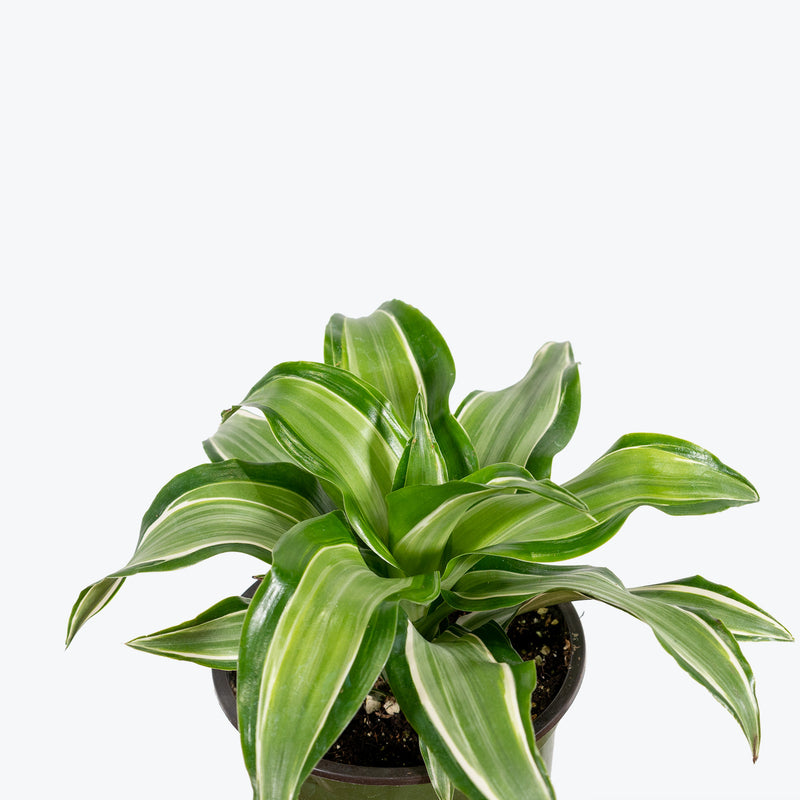
How to care for Dracaena Malaika
They should not be in a position to see the sun directly, although early morning or late evening sun is fine. Filtered sunlight through a sheer curtain is best and most homes are comprised primarily of indirect sunlight. The best spot for them is where they do not see the sun during the majority of the day but still get bright, indirect light.
They will thrive in medium to bright light, but also can tolerate low light. A good medium-light place in your home would be in the middle of a room that has a regular size window. They can be placed almost anywhere in the room but remember, plants will grow based on how much light they receive.
They like the soil to be relatively dry before the next watering. That usually takes about 2 weeks in an average home environment. It will vary depending on the time of year, your environment and lighting conditions, but for them, it's always safer to underwater or water when you see signs of lack of water (i.e. droopy, floppy, or soft leaves). Expect to water more often in brighter light and less often in lower light.
They will do well in average humidity environments but will appreciate a little bit of humidity if provided, give them a mist daily or get a humidifier.
Avoid allowing the soil to dry completely. Be sure to water slowly near the base of the plant as Dracaena have shallow roots. Place your plant away from hot or cold air drafts.
This plant is moderately toxic and can cause some adverse reactions when ingested so it is best to not let your pets eat it, which we advise for all plants in general. The severity of the reaction will depend on how much of the plant is ingested but, if you know your pet typically does not eat your plants, this plant will be suitable for your home..
View PlantDracaena Marginata

How to care for Dracaena Marginata
Dracaena Marginata should not be in a position to see the sun directly, although early morning or late evening sun is fine. Filtered sunlight through a sheer curtain is best and most homes are comprised primarily of indirect sunlight. The best spot for them is where they do not see the sun during the majority of the day but still get bright, indirect light.
Dracaena Marginata will thrive in medium to bright light, but also can tolerate low light. A good medium-light place in your home would be in the middle of a room that has a regular size window. They can be placed almost anywhere in the room but remember, plants will grow based on how much light they receive.
Dracaena Marginata likes the soil to be relatively dry before the next watering. That usually takes about 2 weeks in an average home environment. It will vary depending on the time of year, your environment and lighting conditions, but for them, it's always safer to underwater or water when you see signs of lack of water (i.e. droopy, floppy, or soft leaves). Water more often in the warmer months.
Dracaena Marginata will do well in average humidity environments but will appreciate a little bit of humidity if provided, give them a mist daily or get a humidifier!
Avoid allowing the soil to dry completely. Be sure to water Dracaena Marginata slowly near the base of the plant as they have shallow roots. Place your Dracaena Marginata away from hot or cold air drafts. Don't be too surprised if they shed a few leaves as it adjusts to your home, this is completely normal! Prune the top of the plant if it becomes too tall or leggy, which will encourage the growth of side shoots and make the plant bushier.
Dracaena Marginata is moderately toxic and can cause some adverse reactions when ingested so it is best to not let your pets eat it, which we advise for all plants in general. The severity of the reaction will depend on how much of the plant is ingested but, if you know your pet typically does not eat your plants, this plant will be suitable for your home..
View PlantDracaena Marginata Bicolor

How to care for Dracaena Marginata Bicolor
Dracaena Marginata Bicolor should not be in a position to see the sun directly, although early morning or late evening sun is fine. Filtered sunlight through a sheer curtain is best and most homes are comprised primarily of indirect sunlight. The best spot for them is where they do not see the sun during the majority of the day but still get bright, indirect light.
Dracaena Marginata Bicolor will thrive in medium to bright light, but also can tolerate low light. A good medium-light place in your home would be in the middle of a room that has a regular size window. They can be placed almost anywhere in the room but remember, plants will grow based on how much light they receive.
Dracaena Marginata Bicolor likes the soil to be relatively dry before the next watering. That usually takes about 2 weeks in an average home environment. It will vary depending on the time of year, your environment and lighting conditions, but for them, it's always safer to underwater or water when you see signs of lack of water (i.e. droopy, floppy, or soft leaves). Water more often in the warmer months.
Dracaena Marginata Bicolor will do well in average humidity environments but will appreciate a little bit of humidity if provided, give them a mist daily or get a humidifier!
Avoid allowing the soil to dry completely. Be sure to water slowly near the base of the plant as Dracaena Marginata Bicolor has shallow roots. Place your plant away from hot or cold air drafts. Don't be too surprised if your plant sheds a few leaves as it adjusts to your home, this is completely normal!
Dracaena Marginata Bicolor is moderately toxic and can cause some adverse reactions when ingested so it is best to not let your pets eat it, which we advise for all plants in general. The severity of the reaction will depend on how much of the plant is ingested but, if you know your pet typically does not eat your plants, this plant will be suitable for your home..
View PlantDracaena Marginata Bonsai

How to care for Dracaena Marginata Bonsai
They should not be in a position to see the sun directly, although early morning or late evening sun is fine. Filtered sunlight through a sheer curtain is best and most homes are comprised primarily of indirect sunlight. The best spot for them is where they do not see the sun during the majority of the day but still get bright, indirect light.
They will thrive in medium to bright light, but also can tolerate low light. A good medium-light place in your home would be in the middle of a room that has a regular size window. They can be placed almost anywhere in the room but remember, plants will grow based on how much light they receive.
They like the soil to be relatively dry before the next watering. That usually takes about 2 weeks in an average home environment. It will vary depending on the time of year, your environment and lighting conditions, but for them, it's always safer to underwater or water when you see signs of lack of water (i.e. droopy, floppy, or soft leaves). Water more often in the warmer months.
They will do well in average humidity environments but will appreciate a little bit of humidity if provided, give them a mist daily or get a humidifier!
Avoid allowing the soil to dry completely. Be sure to water slowly near the base of the plant as Dracaena have shallow roots. Place your plant away from hot or cold air drafts. Don't be too surprised if your plant sheds a few leaves as it adjusts to your home, this is completely normal!
This plant is moderately toxic and can cause some adverse reactions when ingested so it is best to not let your pets eat it, which we advise for all plants in general. The severity of the reaction will depend on how much of the plant is ingested but, if you know your pet typically does not eat your plants, this plant will be suitable for your home..
View PlantDracaena Marginata Bush
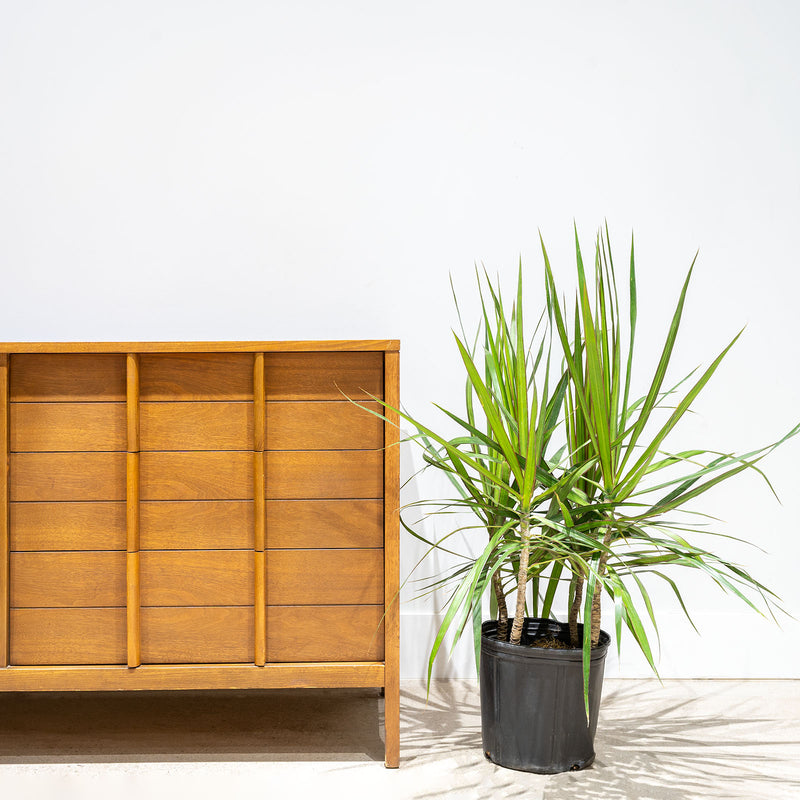
How to care for Dracaena Marginata Bush
They should not be in a position to see the sun directly, although early morning or late evening sun is fine. Filtered sunlight through a sheer curtain is best and most homes are comprised primarily of indirect sunlight. The best spot for them is where they do not see the sun during the majority of the day but still get bright, indirect light.
They will thrive in medium to bright light, but also can tolerate low light. A good medium-light place in your home would be in the middle of a room that has a regular size window. They can be placed almost anywhere in the room but remember, plants will grow based on how much light they receive.
They like the soil to be relatively dry before the next watering. That usually takes about 2 weeks in an average home environment. It will vary depending on the time of year, your environment and lighting conditions, but for them, it's always safer to underwater or water when you see signs of lack of water (i.e. droopy, floppy, or soft leaves). Water more often in the warmer months.
They will do well in average humidity environments but will appreciate a little bit of humidity if provided, give them a mist daily or get a humidifier!
Avoid allowing the soil to dry completely. Be sure to water slowly near the base of the plant as Dracaena have shallow roots. Place your plant away from hot or cold air drafts. Don't be too surprised if your plant sheds a few leaves as it adjusts to your home, this is completely normal!
This plant is moderately toxic and can cause some adverse reactions when ingested so it is best to not let your pets eat it, which we advise for all plants in general. The severity of the reaction will depend on how much of the plant is ingested but, if you know your pet typically does not eat your plants, this plant will be suitable for your home..
View PlantDracaena Marginata Flat Weave
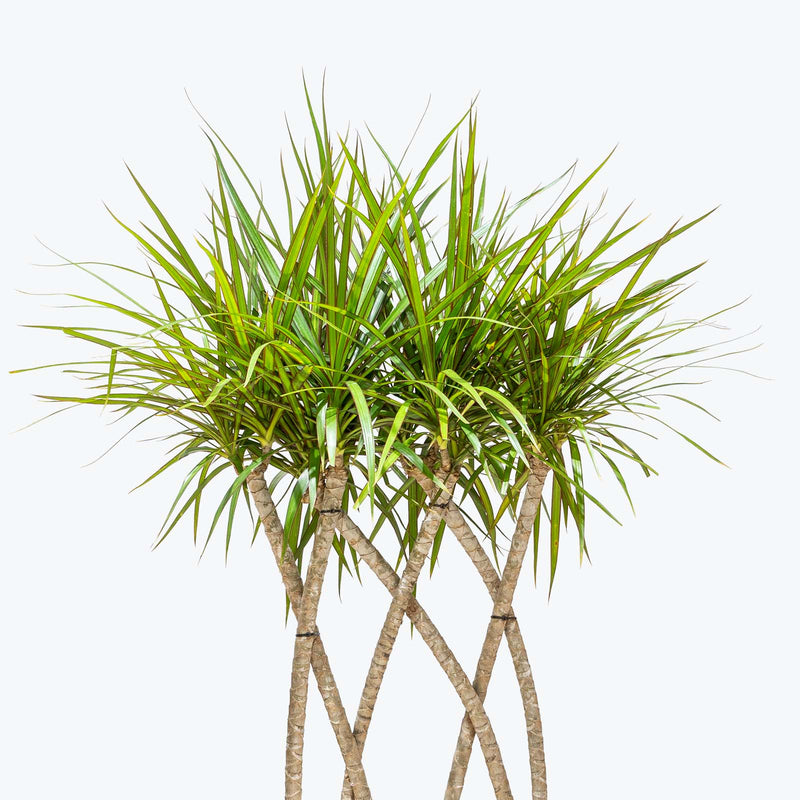
How to care for Dracaena Marginata Flat Weave
They should not be in a position to see the sun directly, although early morning or late evening sun is fine. Filtered sunlight through a sheer curtain is best and most homes are comprised primarily of indirect sunlight. The best spot for them is where they do not see the sun during the majority of the day but still get bright, indirect light.
They will thrive in medium to bright light, but also can tolerate low light. A good medium-light place in your home would be in the middle of a room that has a regular size window. They can be placed almost anywhere in the room but remember, plants will grow based on how much light they receive.
They like the soil to be relatively dry before the next watering. That usually takes about 2 weeks in an average home environment. It will vary depending on the time of year, your environment and lighting conditions, but for them, it's always safer to underwater or water when you see signs of lack of water (i.e. droopy, floppy, or soft leaves). Water more often in the warmer months!
They will do well in average humidity environments but will appreciate a little bit of humidity if provided, give them a mist daily or get a humidifier!
Avoid allowing the soil to dry completely. Be sure to water slowly near the base of the plant as Dracaena have shallow roots. Place your plant away from hot or cold air drafts. Don't be too surprised if your plant sheds a few leaves as it adjusts to your home, this is completely normal!
This plant is moderately toxic and can cause some adverse reactions when ingested so it is best to not let your pets eat it, which we advise for all plants in general. The severity of the reaction will depend on how much of the plant is ingested but, if you know your pet typically does not eat your plants, this plant will be suitable for your home..
View PlantDracaena Marginata Kiwi

How to care for Dracaena Marginata Kiwi
They should not be in a position to see the sun directly, although early morning or late evening sun is fine. Filtered sunlight through a sheer curtain is best and most homes are comprised primarily of indirect sunlight. The best spot for them is where they do not see the sun during the majority of the day but still get bright, indirect light.
They will thrive in medium to bright light, but also can tolerate low light. A good medium-light place in your home would be in the middle of a room that has a regular size window. They can be placed almost anywhere in the room but remember, plants will grow based on how much light they receive.
They like the soil to be relatively dry before the next watering. That usually takes about 2 weeks in an average home environment. It will vary depending on the time of year, your environment and lighting conditions, but for them, it's always safer to underwater or water when you see signs of lack of water (i.e. droopy, floppy, or soft leaves). Water more often in the warmer months!
They will do well in average humidity environments but will appreciate a little bit of humidity if provided, give them a mist daily or get a humidifier!
Avoid allowing the soil to dry completely. Be sure to water slowly near the base of the plant as Dracaena have shallow roots. Place your plant away from hot or cold air drafts. Don't be too surprised if your plant sheds a few leaves as it adjusts to your home, this is completely normal!
This plant is moderately toxic and can cause some adverse reactions when ingested so it is best to not let your pets eat it, which we advise for all plants in general. The severity of the reaction will depend on how much of the plant is ingested but, if you know your pet typically does not eat your plants, this plant will be suitable for your home..
View PlantDracaena Marginata Open Weave
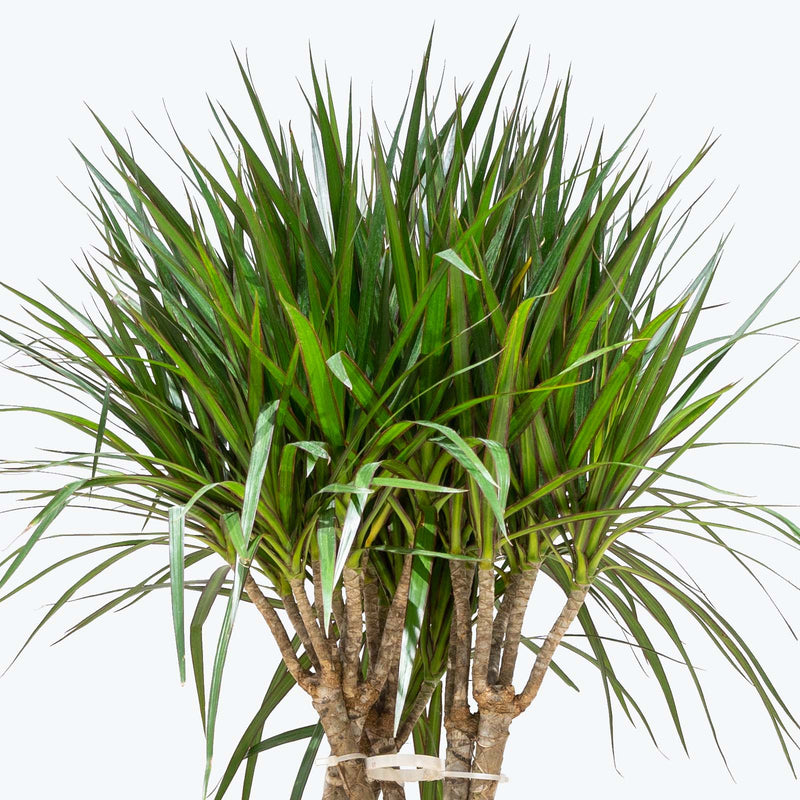
How to care for Dracaena Marginata Open Weave
They should not be in a position to see the sun directly, although early morning or late evening sun is fine. Filtered sunlight through a sheer curtain is best and most homes are comprised primarily of indirect sunlight. The best spot for them is where they do not see the sun during the majority of the day but still get bright, indirect light.
They will thrive in medium to bright light, but also can tolerate low light. A good medium-light place in your home would be in the middle of a room that has a regular size window. They can be placed almost anywhere in the room but remember, plants will grow based on how much light they receive.
They like the soil to be relatively dry before the next watering. That usually takes about 2 weeks in an average home environment. It will vary depending on the time of year, your environment and lighting conditions, but for them, it's always safer to underwater or water when you see signs of lack of water (i.e. droopy, floppy, or soft leaves). Water more often in the warmer months!
They will do well in average humidity environments but will appreciate a little bit of humidity if provided, give them a mist daily or get a humidifier!
Avoid allowing the soil to dry completely. Be sure to water slowly near the base of the plant as Dracaena have shallow roots. Place your plant away from hot or cold air drafts. Don't be too surprised if your plant sheds a few leaves as it adjusts to your home, this is completely normal!
This plant is moderately toxic and can cause some adverse reactions when ingested so it is best to not let your pets eat it, which we advise for all plants in general. The severity of the reaction will depend on how much of the plant is ingested but, if you know your pet typically does not eat your plants, this plant will be suitable for your home..
View PlantDracaena Marginata Staggered
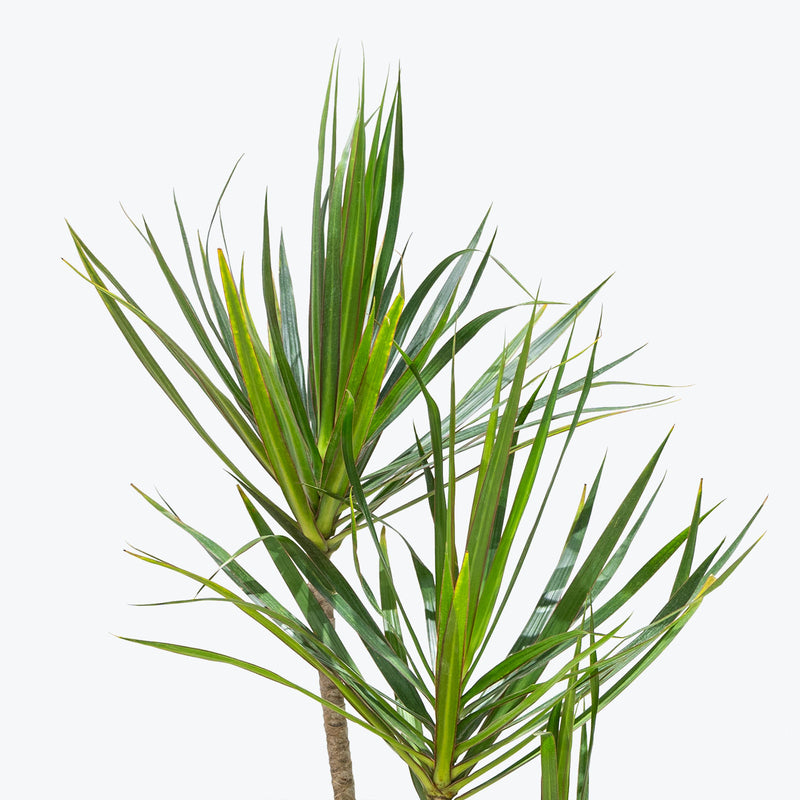
How to care for Dracaena Marginata Staggered
Dracaena Marginata Staggered should not be in a position to see the sun directly, although early morning or late evening sun is fine. Filtered sunlight through a sheer curtain is best and most homes are comprised primarily of indirect sunlight. The best spot for them is where they do not see the sun during the majority of the day but still get bright, indirect light.
Dracaena Marginata Staggered will thrive in medium to bright light, but also can tolerate low light. A good medium-light place in your home would be in the middle of a room that has a regular size window. They can be placed almost anywhere in the room but remember, plants will grow based on how much light they receive.
Dracaena Marginata Staggered likes the soil to be relatively dry before the next watering. That usually takes about 2 weeks in an average home environment. It will vary depending on the time of year, your environment and lighting conditions, but for them, it's always safer to underwater or water when you see signs of lack of water (i.e. droopy, floppy, or soft leaves). Water more often in the warmer months.
Dracaena Marginata Staggered will do well in average humidity environments but will appreciate a little bit of humidity if provided, give them a mist daily or get a humidifier!
Fertilize Dracaena Marginata Staggered with a balanced liquid fertilizer every 6 weeks during the spring and summer months to encourage growth. Pruning the top can help the plant to become bushier and manage its height. Wipe the leaves with a damp cloth occasionally to remove dust and keep them looking vibrant. Avoid allowing the soil to dry completely. Be sure to water slowly near the base of the plant as Dracaena has shallow roots. Place your plant away from hot or cold air drafts. Don't be too surprised if your plant sheds a few leaves as it adjusts to your home, this is completely normal!
Dracaena Marginata Staggered is moderately toxic and can cause some adverse reactions when ingested so it is best to not let your pets eat it, which we advise for all plants in general. The severity of the reaction will depend on how much of the plant is ingested but, if you know your pet typically does not eat your plants, this plant will be suitable for your home..
View PlantDracaena Marginata Stump

How to care for Dracaena Marginata Stump
They should not be in a position to see the sun directly, although early morning or late evening sun is fine. Filtered sunlight through a sheer curtain is best and most homes are comprised primarily of indirect sunlight. The best spot for them is where they do not see the sun during the majority of the day but still get bright, indirect light.
They will thrive in medium to bright light, but also can tolerate low light. A good medium-light place in your home would be in the middle of a room that has a regular size window. They can be placed almost anywhere in the room but remember, plants will grow based on how much light they receive.
They like the soil to be relatively dry before the next watering. That usually takes about 2 weeks in an average home environment. It will vary depending on the time of year, your environment and lighting conditions, but for them, it's always safer to underwater or water when you see signs of lack of water (i.e. droopy, floppy, or soft leaves). Water more often in the warmer months.
They will do well in average humidity environments but will appreciate a little bit of humidity if provided, give them a mist daily or get a humidifier!
Avoid allowing the soil to dry completely. Be sure to water slowly near the base of the plant as Dracaena have shallow roots. Place your plant away from hot or cold air drafts. Don't be too surprised if your plant sheds a few leaves as it adjusts to your home, this is completely normal!
This plant is moderately toxic and can cause some adverse reactions when ingested so it is best to not let your pets eat it, which we advise for all plants in general. The severity of the reaction will depend on how much of the plant is ingested but, if you know your pet typically does not eat your plants, this plant will be suitable for your home..
View PlantDracaena Marginata Tricolor

How to care for Dracaena Marginata Tricolor
Dracaena Marginata Tricolor should not be in a position to see the sun directly, although early morning or late evening sun is fine. Filtered sunlight through a sheer curtain is best and most homes are comprised primarily of indirect sunlight. The best spot for them is where they do not see the sun during the majority of the day but still get bright, indirect light.
Dracaena Marginata Tricolor will thrive in medium to bright light, but also can tolerate low light. A good medium-light place in your home would be in the middle of a room that has a regular size window. They can be placed almost anywhere in the room but remember, plants will grow based on how much light they receive.
Dracaena Marginata Tricolor needs to be watered when the top half of the soil is dry to the touch. That usually takes about 1 week in an average home environment. It will vary depending on the time of year, your environment and lighting conditions, but it's always safer to underwater or give the soil a check before you water again. Expect to water more often in brighter light and less often in lower light.
Dracaena Marginata Tricolor will do well in average humidity environments but will appreciate a little bit of humidity if provided, give them a mist daily or get a humidifier.
Wipe the long leaves occasionally to keep their colours shining and dust-free. Rotate Dracaena Marginata Tricolor every few weeks to encourage even growth. If the tips brown, it may be due to fluoride or chlorine in tap water—switching to filtered or distilled water helps. Dracaena marginata grows slowly indoors but can reach impressive heights over time.
Dracaena Marginata Tricolor is moderately toxic and can cause some adverse reactions when ingested so it is best to not let your pets eat it, which we advise for all plants in general. The severity of the reaction will depend on how much of the plant is ingested but, if you know your pet typically does not eat your plants, this plant will be suitable for your home..
View PlantDracaena Marley

How to care for Dracaena Marley
They should not be in a position to see the sun directly, although early morning or late evening sun is fine. Filtered sunlight through a sheer curtain is best and most homes are comprised primarily of indirect sunlight. The best spot for them is where they do not see the sun during the majority of the day but still get bright, indirect light.
They will do well in medium light but will grow faster with brighter light. A good medium-light place in your home would be in the middle of a room that has a regular size window. Remember that plants will grow based on how much light they receive.
They like the soil to be relatively dry before the next watering. That usually takes about 2 weeks in an average home environment. It will vary depending on the time of year, your environment and lighting conditions, but for them, it's always safer to underwater or water when you see signs of lack of water (i.e. droopy, floppy, or soft leaves). Expect to water more often in brighter light and less often in lower light.
They will do well in average humidity environments but will appreciate a little bit of humidity if provided, give them a mist daily or get a humidifier.
Avoid allowing the soil to dry completely. Be sure to water slowly near the base of the plant as Dracaena have shallow roots. Place your plant away from hot or cold air drafts.
This plant is moderately toxic and can cause some adverse reactions when ingested so it is best to not let your pets eat it, which we advise for all plants in general. The severity of the reaction will depend on how much of the plant is ingested but, if you know your pet typically does not eat your plants, this plant will be suitable for your home..
View PlantDracaena Reflexa
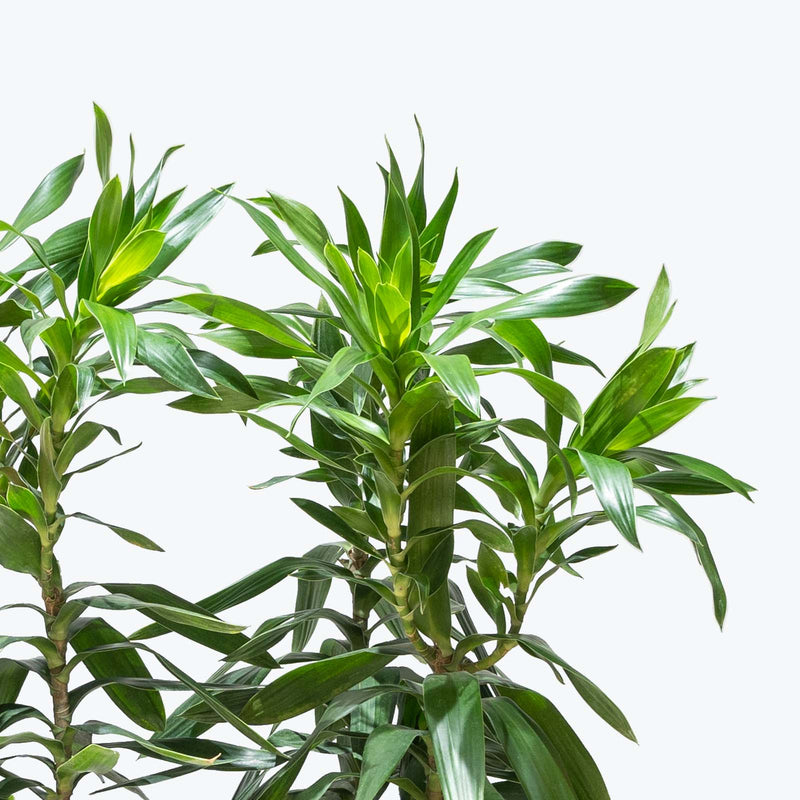
How to care for Dracaena Reflexa
Dracaena Reflexa should not be in a position to see the sun directly, although early morning or late evening sun is fine. Filtered sunlight through a sheer curtain is best and most homes are comprised primarily of indirect sunlight. The best spot for them is where they do not see the sun during the majority of the day but still get bright, indirect light.
Dracaena Reflexa will thrive in medium to bright light, but also can tolerate low light. A good medium-light place in your home would be in the middle of a room that has a regular size window. They can be placed almost anywhere in the room but remember, plants will grow based on how much light they receive.
Dracaena Reflexa likes the soil to be relatively dry before the next watering. That usually takes about 2 weeks in an average home environment. It will vary depending on the time of year, your environment and lighting conditions, but for them, it's always safer to underwater or water when you see signs of lack of water (i.e. droopy, floppy, or soft leaves). Water more often in the warmer months!
Dracaena Reflexa will do well in average humidity environments but will appreciate a little bit of humidity if provided, give them a mist daily or get a humidifier!
Remove any brown or yellowing leaves to maintain Dracaena Reflexa's appearance and promote healthy growth. Repot Dracaena Reflexa every 2-3 years, as needed, to refresh the soil and provide room for growth. Avoid overwatering, as this can lead to root rot.
Dracaena Reflexa is moderately toxic and can cause some adverse reactions when ingested so it is best to not let your pets eat it, which we advise for all plants in general. The severity of the reaction will depend on how much of the plant is ingested but, if you know your pet typically does not eat your plants, this plant will be suitable for your home..
View PlantDracaena Reflexa Anita Variegata

How to care for Dracaena Reflexa Anita Variegata
Dracaena Reflexa Anita Variegata should not be in a position to see the sun directly, although early morning or late evening sun is fine. Filtered sunlight through a sheer curtain is best and most homes are comprised primarily of indirect sunlight. The best spot for them is where they do not see the sun during the majority of the day but still get bright, indirect light.
Dracaena Reflexa Anita Variegata will thrive in medium to bright light, but also can tolerate low light. A good medium-light place in your home would be in the middle of a room that has a regular size window. They can be placed almost anywhere in the room but remember, plants will grow based on how much light they receive.
Dracaena Reflexa Anita Variegata likes the soil to be relatively dry before the next watering. That usually takes about 2 weeks in an average home environment. It will vary depending on the time of year, your environment and lighting conditions, but for them, it's always safer to underwater or water when you see signs of lack of water (i.e. droopy, floppy, or soft leaves). Water more often in the warmer months!
Dracaena Reflexa Anita Variegata will do well in average humidity environments but will appreciate a little bit of humidity if provided, give them a mist daily or get a humidifier!
Avoid allowing the soil to dry completely. Be sure to water slowly near the base of the plant as Dracaena have shallow roots. Place your Dracaena Reflexa Anita Variegata away from hot or cold air drafts.
This plant is moderately toxic and can cause some adverse reactions when ingested so it is best to not let your pets eat it, which we advise for all plants in general. The severity of the reaction will depend on how much of the plant is ingested but, if you know your pet typically does not eat your plants, this plant will be suitable for your home..
View PlantDracaena Reflexa Variegata
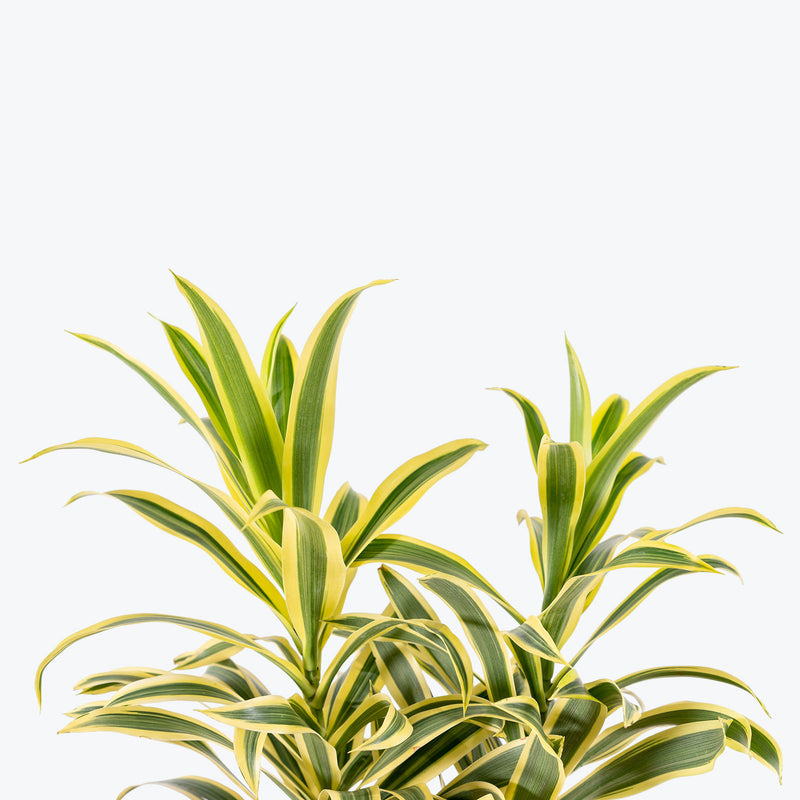
How to care for Dracaena Reflexa Variegata
They should not be in a position to see the sun directly, although early morning or late evening sun is fine. Filtered sunlight through a sheer curtain is best and most homes are comprised primarily of indirect sunlight. The best spot for them is where they do not see the sun during the majority of the day but still get bright, indirect light.
They will thrive in medium to bright light, but also can tolerate low light. A good medium-light place in your home would be in the middle of a room that has a regular size window. They can be placed almost anywhere in the room but remember, plants will grow based on how much light they receive.
They like the soil to be relatively dry before the next watering. That usually takes about 2 weeks in an average home environment. It will vary depending on the time of year, your environment and lighting conditions, but for them, it's always safer to underwater or water when you see signs of lack of water (i.e. droopy, floppy, or soft leaves). Water more often in the warmer months!
They will do well in average humidity environments but will appreciate a little bit of humidity if provided, give them a mist daily or get a humidifier!
Avoid allowing the soil to dry completely. Be sure to water slowly near the base of the plant as Dracaena have shallow roots. Place your plant away from hot or cold air drafts.
This plant is moderately toxic and can cause some adverse reactions when ingested so it is best to not let your pets eat it, which we advise for all plants in general. The severity of the reaction will depend on how much of the plant is ingested but, if you know your pet typically does not eat your plants, this plant will be suitable for your home..
View PlantDracaena Twister
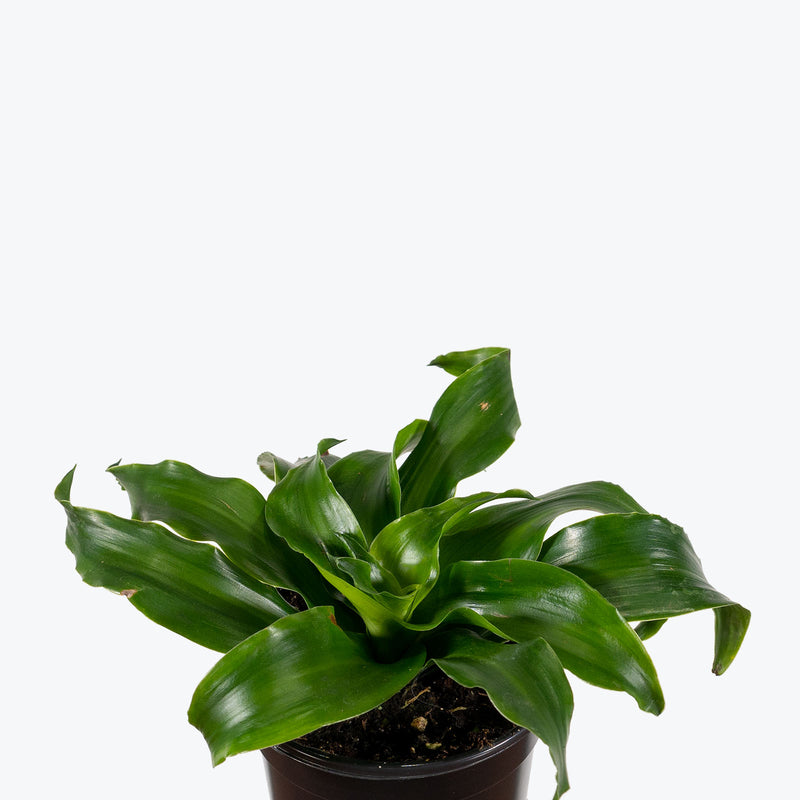
How to care for Dracaena Twister
They should not be in a position to see the sun directly, although early morning or late evening sun is fine. Filtered sunlight through a sheer curtain is best and most homes are comprised primarily of indirect sunlight. The best spot for them is where they do not see the sun during the majority of the day but still get bright, indirect light.
They will thrive in medium to bright light, but also can tolerate low light. A good medium-light place in your home would be in the middle of a room that has a regular size window. They can be placed almost anywhere in the room but remember, plants will grow based on how much light they receive.
They like the soil to be relatively dry before the next watering. That usually takes about 2 weeks in an average home environment. It will vary depending on the time of year, your environment and lighting conditions, but for them, it's always safer to underwater or water when you see signs of lack of water (i.e. droopy, floppy, or soft leaves). Expect to water more often in brighter light and less often in lower light.
They will do well in average humidity environments but will appreciate a little bit of humidity if provided, give them a mist daily or get a humidifier.
Avoid allowing the soil to dry completely. Be sure to water slowly near the base of the plant as Dracaena have shallow roots. Place your plant away from hot or cold air drafts.
This plant is moderately toxic and can cause some adverse reactions when ingested so it is best to not let your pets eat it, which we advise for all plants in general. The severity of the reaction will depend on how much of the plant is ingested but, if you know your pet typically does not eat your plants, this plant will be suitable for your home..
View PlantDracaena Warneckii
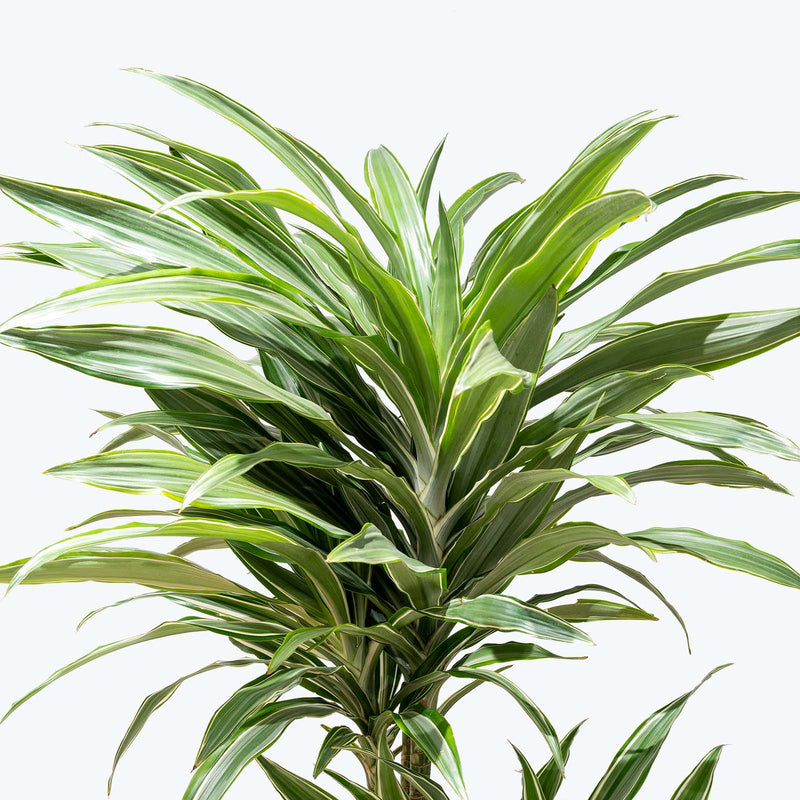
How to care for Dracaena Warneckii
They should not be in a position to see the sun directly, although early morning or late evening sun is fine. Filtered sunlight through a sheer curtain is best and most homes are comprised primarily of indirect sunlight. The best spot for them is where they do not see the sun during the majority of the day but still get bright, indirect light.
They will thrive in medium to bright light, but also can tolerate low light. A good medium-light place in your home would be in the middle of a room that has a regular size window. They can be placed almost anywhere in the room but remember, plants will grow based on how much light they receive.
They like the soil to be relatively dry before the next watering. That usually takes about 2 weeks in an average home environment. It will vary depending on the time of year, your environment and lighting conditions, but for them, it's always safer to underwater or water when you see signs of lack of water (i.e. droopy, floppy, or soft leaves). Water more often in the warmer months!
They will do well in average humidity environments but will appreciate a little bit of humidity if provided, give them a mist daily or get a humidifier!
Avoid allowing the soil to dry completely. Be sure to water slowly near the base of the plant as Dracaena have shallow roots. Place your plant away from hot or cold air drafts.
This plant is moderately toxic and can cause some adverse reactions when ingested so it is best to not let your pets eat it, which we advise for all plants in general. The severity of the reaction will depend on how much of the plant is ingested but, if you know your pet typically does not eat your plants, this plant will be suitable for your home..
View PlantDracaena White Surprise

How to care for Dracaena White Surprise
Dracaena White Surprise should not be in a position to see the sun directly, although early morning or late evening sun is fine. Filtered sunlight through a sheer curtain is best and most homes are comprised primarily of indirect sunlight. The best spot for them is where they do not see the sun during the majority of the day but still get bright, indirect light.
Dracaena White Surprise will thrive in medium to bright light, but also can tolerate low light. A good medium-light place in your home would be in the middle of a room that has a regular size window. They can be placed almost anywhere in the room but remember, plants will grow based on how much light they receive.
Dracaena White Surprise likes the soil to be relatively dry before the next watering. That usually takes about 2 weeks in an average home environment. It will vary depending on the time of year, your environment and lighting conditions, but for them, it's always safer to underwater or water when you see signs of lack of water (i.e. droopy, floppy, or soft leaves). Expect to water more often in brighter light and less often in lower light.
Dracaena White Surprise will do well in average humidity environments but will appreciate a little bit of humidity if provided, give them a mist daily or get a humidifier.
Avoid allowing the soil to dry completely. Be sure to water slowly near the base of the plant as Dracaena White Surprise has shallow roots. Place away from hot or cold air drafts. Fertilize with a balanced, liquid fertilizer every six weeks during the growing season (spring and summer). Reduce feeding during the fall and winter when growth naturally slows. Clean the leaves occasionally with a soft, damp cloth to remove dust and help the plant breathe and photosynthesize more efficiently. If the plant becomes too tall, you can prune the top to encourage bushier growth.
Dracaena White Surprise is moderately toxic and can cause some adverse reactions when ingested so it is best to not let your pets eat it, which we advise for all plants in general. The severity of the reaction will depend on how much of the plant is ingested but, if you know your pet typically does not eat your plants, this plant will be suitable for your home..
View PlantDragon Tail Pothos
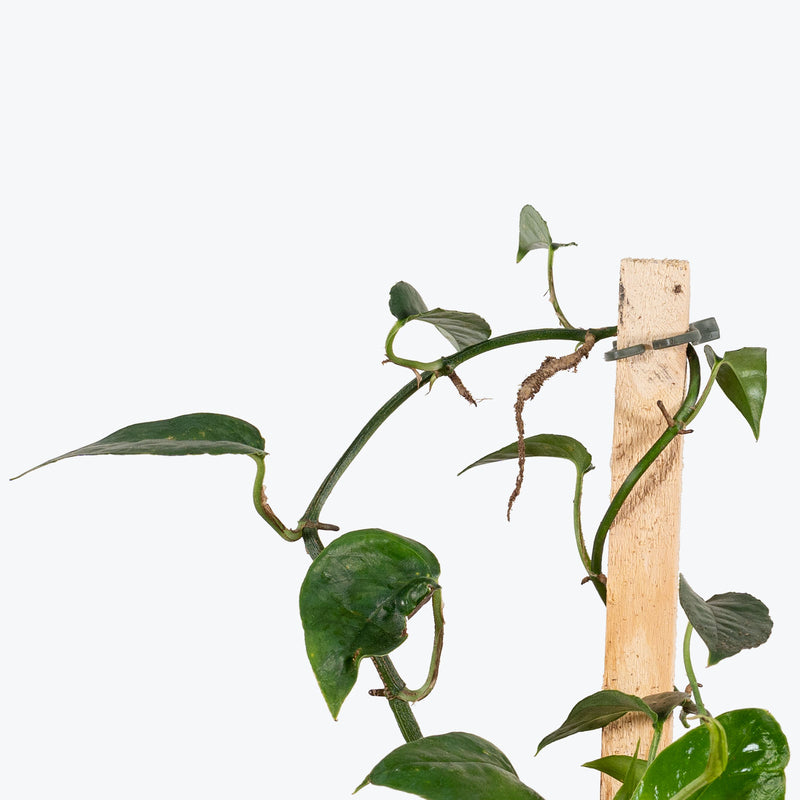
How to care for Dragon Tail Pothos
Dragon Tail Pothos should not be in a position to see the sun directly, although early morning or late evening sun is fine. Filtered sunlight through a sheer curtain is best and most homes are comprised primarily of indirect sunlight. The best spot for them is where they do not see the sun during the majority of the day but still get bright, indirect light.
Dragon Tail Pothos will thrive in medium to bright light, but also can tolerate low light. A good medium-light place in your home would be in the middle of a room that has a regular size window. They can be placed almost anywhere in the room but remember, plants will grow based on how much light they receive.
Dragon Tail Pothos likes the soil to be relatively dry before the next watering. That usually takes about 2 weeks in an average home environment. It will vary depending on the time of year, your environment and lighting conditions, but for them, it's always safer to underwater or water when you see signs of lack of water (i.e. droopy, floppy, or soft leaves). Expect to water more often in brighter light and less often in lower light.
Dragon Tail Pothos can live in any average home humidity condition and are fairly hardy.
Even though Dragon Tail Pothos can tolerate lower light, if you want full, lush foliage, it would be better to keep your plant in a location with medium to bright, indirect light - your plant would greatly benefit from some morning sunlight. Feel free to trim your Pothos regularly as this encourages the plant to develop more side-shoots and reduces the demand for the plant to develop a larger root system while confined. Their cuttings propagate very easily in water.
Dragon Tail Pothos is moderately toxic and can cause some adverse reactions when ingested so it is best to not let your pets eat it, which we advise for all plants in general. The severity of the reaction will depend on how much of the plant is ingested but, if you know your pet typically does not eat your plants, this plant will be suitable for your home..
Learn MoreView PlantDrosera Aliciae
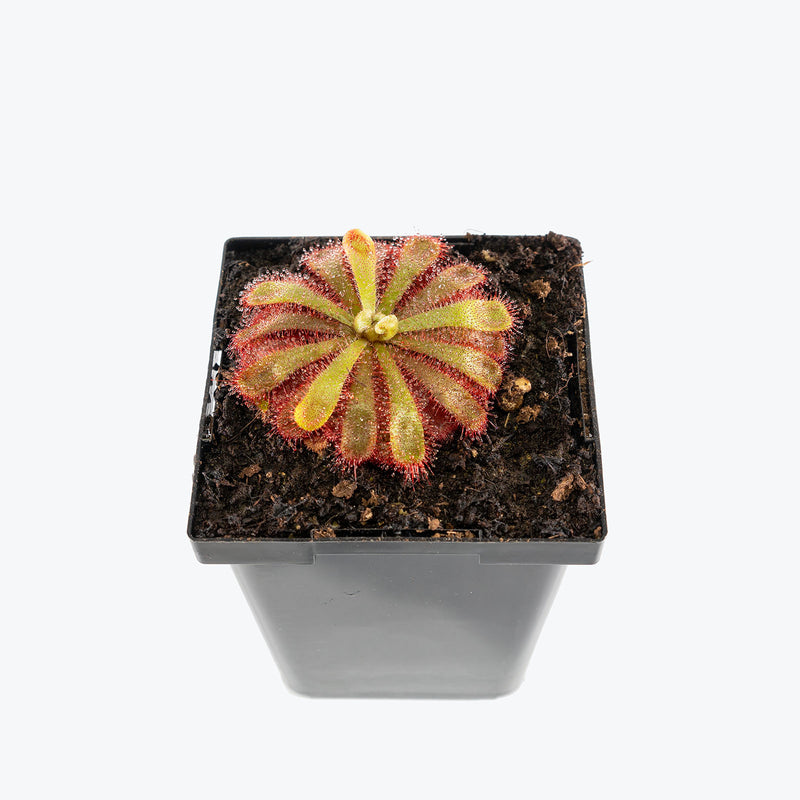
How to care for Drosera Aliciae
Drosera Aliciae enjoys some direct sun, but they'll also do well in bright, indirect light. It is best to place this plant somewhere where it will receive some nice morning sun, or a couple hours of afternoon sun, and then indirect light the rest of the day.
Drosera Aliciae will do best in bright light. A nice bright place inside your home would be on the window sill or a stool that is right next to a window, either with or without blinds, depending on if the plant can handle sun. Remember that plants will grow based on how much light they receive.
Drosera Aliciae likes the soil to stay consistently moist, but not soaking wet. Give them water whenever just the surface of the soil is starting to get dry. Expect to water more often in brighter light and less often in lower light.
Drosera Aliciae likes a high humidity environment, give them a mist daily or as often as possible. Alternatively, you can put them around a humidifier. Although they won't die if they don't receive enough humidity, their leaves may have some dry, crunchy, or yellow edges.
Avoid fertilizing directly as Drosera Aliciae captures its nutrients from insects. Prune dead leaves and spent flowers to encourage new growth and prevent decay. During winter, the plant may enter a period of slower growth; reduce watering slightly, but ensure the soil remains moist.
You can feel comfortable having Drosera Aliciae around your home in the potential case where your pet feels like nibbling on it. However, we typically recommend keeping your pets from eating any of your houseplants..
View PlantDrosera Andromeda
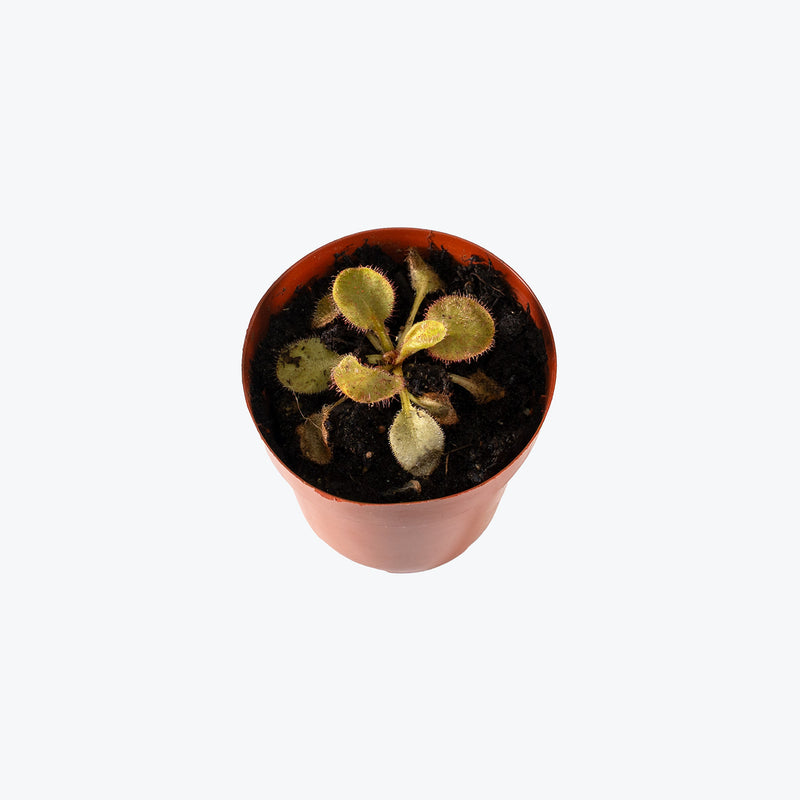
How to care for Drosera Andromeda
Drosera Andromeda should not be in a position to see the sun directly, although early morning or late evening sun is fine. Filtered sunlight through a sheer curtain is best and most homes are comprised primarily of indirect sunlight. The best spot for them is where they do not see the sun during the majority of the day but still get bright, indirect light.
Drosera Andromeda will thrive in medium to bright light, but also can tolerate low light. A good medium-light place in your home would be in the middle of a room that has a regular size window. They can be placed almost anywhere in the room, but remember, plants will grow based on how much light they receive.
Drosera Andromeda likes the soil to stay consistently moist, but not soaking wet. Give them water whenever just the surface of the soil is starting to get dry. Expect to water more often in brighter light and less often in lower light.
Drosera Andromeda likes a high humidity environment, give them a mist daily or as often as possible. Alternatively, you can put them around a humidifier. Although they won't die if they don't receive enough humidity, their leaves may have some dry, crunchy, or yellow edges.
Best grown in a cool, humid terrarium with a mix of sphagnum moss and perlite. Keep temperatures moderate (65–75°F / 18–24°C) and avoid heat stress. Since leaf movement is limited, don’t be alarmed if it doesn’t curl around prey—the plant still digests insects effectively through its dew. Feed Drosera Andromeda occasionally with very small insects if not grown where it can catch its own prey.
You can feel comfortable having Drosera Andromeda around your home in the potential case where your pet feels like nibbling on it. However, we typically recommend keeping your pets from eating any of your houseplants..
View PlantDrosera Capensis
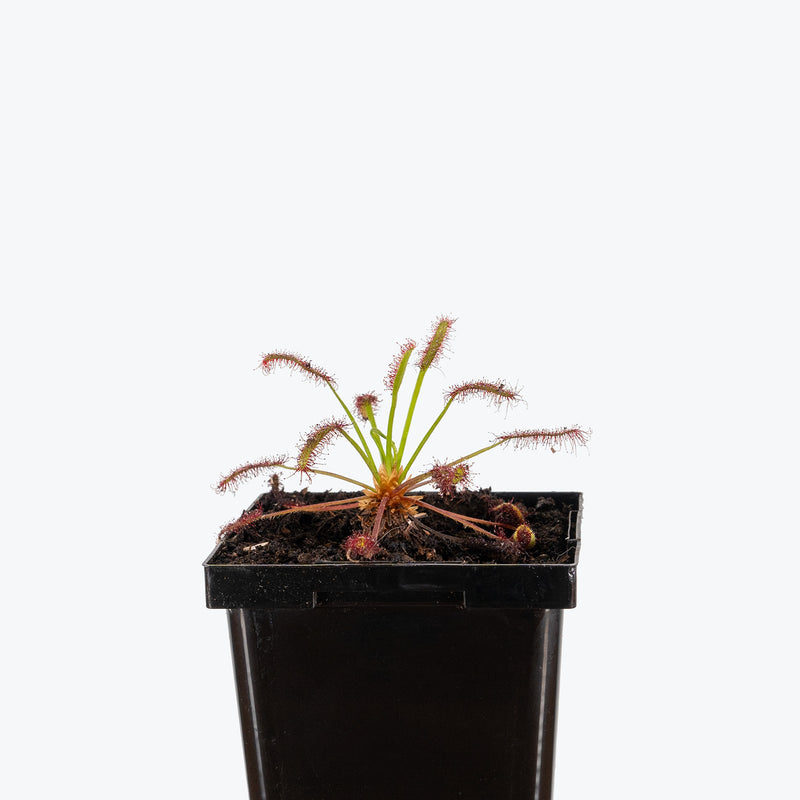
How to care for Drosera Capensis
Drosera Capensis enjoys some direct sun, but they'll also do well in bright, indirect light. It is best to place this plant somewhere where it will receive some nice morning sun, or a couple hours of afternoon sun, and then indirect light the rest of the day.
Drosera Capensis will do best in bright light. A nice bright place inside your home would be on the window sill or a stool that is right next to a window, either with or without blinds, depending on if the plant can handle sun. Remember that plants will grow based on how much light they receive.
Drosera Capensis likes the soil to stay consistently moist, but not soaking wet. Give them water whenever just the surface of the soil is starting to get dry. Expect to water more often in brighter light and less often in lower light.
Drosera Capensis likes a high humidity environment, give them a mist daily or as often as possible. Alternatively, you can put them around a humidifier. Although they won't die if they don't receive enough humidity, their leaves may have some dry, crunchy, or yellow edges.
Avoid fertilizing as the Drosera Capensis obtains all necessary nutrients from its prey. Deadhead spent flowers to conserve the plant's energy for leaf production. During winter, the plant may enter a period of slower growth; reduce watering slightly, but ensure the soil remains moist.
You can feel comfortable having Drosera Capensis around your home in the potential case where your pet feels like nibbling on it. However, we typically recommend keeping your pets from eating any of your houseplants..
View PlantDrosera Capensis Alba
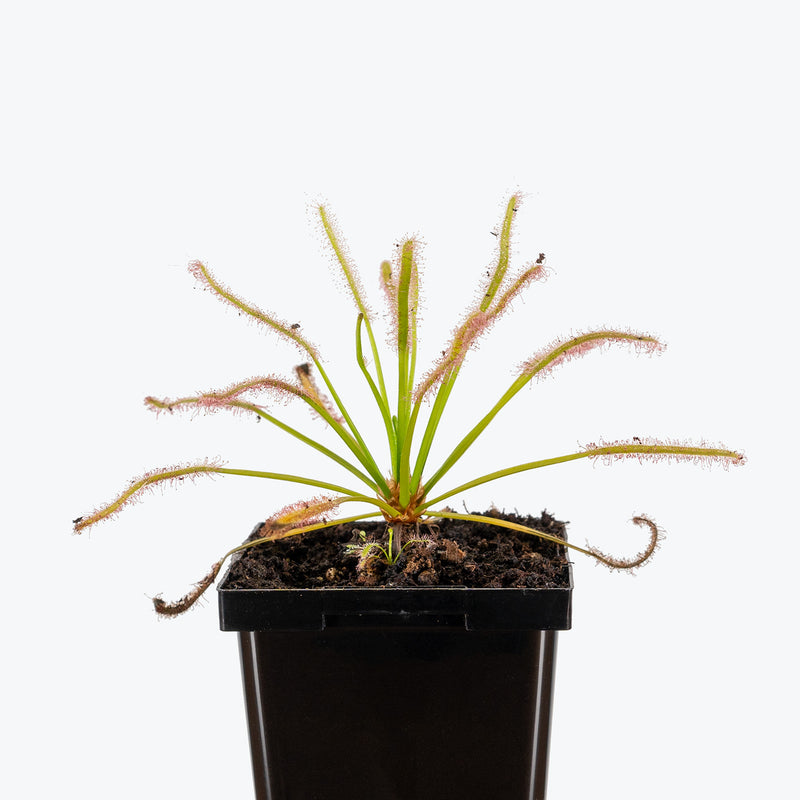
How to care for Drosera Capensis Alba
Drosera Capensis Alba enjoys some direct sun, but they'll also do well in bright, indirect light. It is best to place this plant somewhere where it will receive some nice morning sun, or a couple hours of afternoon sun, and then indirect light the rest of the day.
Drosera Capensis Alba will do best in bright light. A nice bright place inside your home would be on the window sill or a stool that is right next to a window, either with or without blinds, depending on if the plant can handle sun. Remember that plants will grow based on how much light they receive.
Drosera Capensis Alba likes the soil to stay consistently moist, but not soaking wet. Give them water whenever just the surface of the soil is starting to get dry. Expect to water more often in brighter light and less often in lower light.
Drosera Capensis Alba likes a high humidity environment, give them a mist daily or as often as possible. Alternatively, you can put them around a humidifier. Although they won't die if they don't receive enough humidity, their leaves may have some dry, crunchy, or yellow edges.
No fertilization is needed as Drosera Capensis Alba gains nutrients from the insects it consumes. During winter or cooler temperatures, growth may slow down, but the plant should maintain its traps. Prune dead leaves and spent flowers to encourage new growth. Regularly check for pests or fungal issues, although this species is generally robust and pest-resistant.
You can feel comfortable having Drosera Capensis Alba around your home in the potential case where your pet feels like nibbling on it. However, we typically recommend keeping your pets from eating any of your houseplants..
View PlantDrosera Esterhuyseniae x Slackii
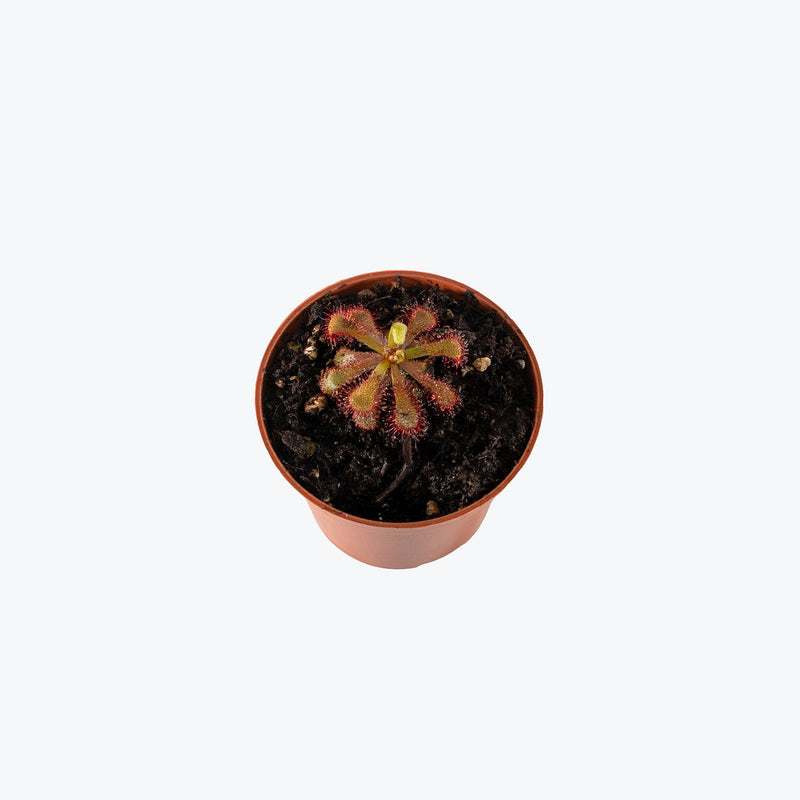
How to care for Drosera Esterhuyseniae x Slackii
Drosera Esterhuyseniae x Slackii should not be in a position to see the sun directly, although early morning or late evening sun is fine. Filtered sunlight through a sheer curtain is best and most homes are comprised primarily of indirect sunlight. The best spot for them is where they do not see the sun during the majority of the day but still get bright, indirect light.
Drosera Esterhuyseniae x Slackii will thrive in bright light, but also can tolerate medium light. A good medium-light place in your home would be in the middle of a room that has a regular size window. They can be placed anywhere between the middle of the room and the window. Remember that plants will grow based on how much light they receive.
Drosera Esterhuyseniae x Slackii likes the soil to stay consistently moist, but not soaking wet. Give them water whenever just the surface of the soil is starting to get dry. Expect to water more often in brighter light and less often in lower light.
Drosera Esterhuyseniae x Slackii likes a high humidity environment, give them a mist daily or as often as possible. Alternatively, you can put them around a humidifier. Although they won't die if they don't receive enough humidity, their leaves may have some dry, crunchy, or yellow edges.
Drosera Esterhuyseniae x Slackii prefers cooler growing conditions (60–75°F / 16–24°C), especially during summer heat. If conditions become too warm, provide dappled or filtered light to reduce stress. Plant in a mix of sphagnum moss and sand or perlite for excellent drainage. Feed occasionally with small insects or diluted foliar spray if grown indoors.
You can feel comfortable having Drosera Esterhuyseniae x Slackii around your home in the potential case where your pet feels like nibbling on it. However, we typically recommend keeping your pets from eating any of your houseplants..
View PlantDrosera Spatulata
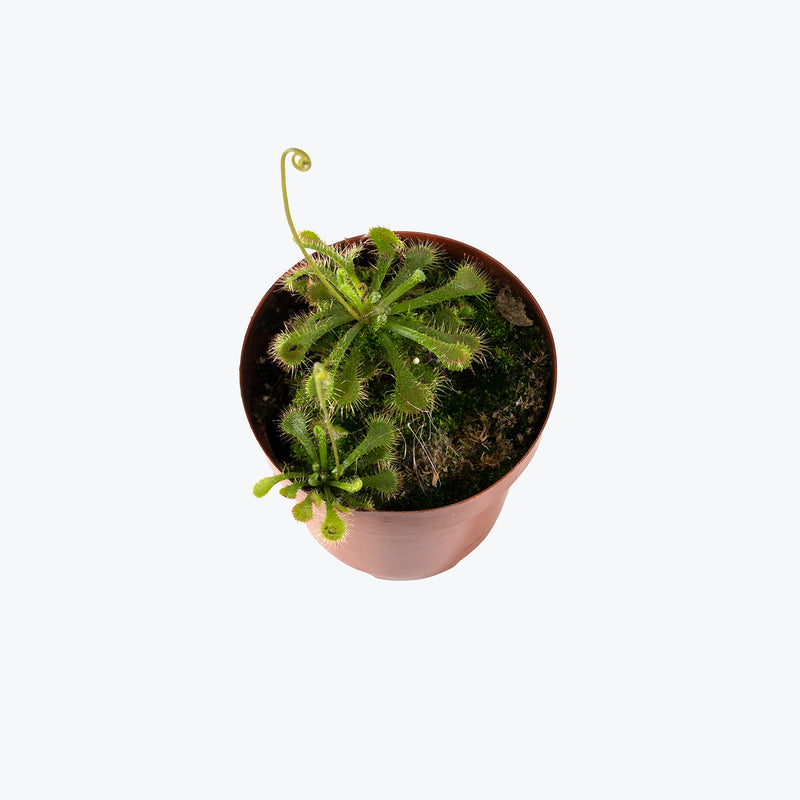
How to care for Drosera Spatulata
Drosera Spatulata enjoys some direct sun, but they'll also do well in bright, indirect light. It is best to place this plant somewhere where it will receive some nice morning sun, or a couple hours of afternoon sun, and then indirect light the rest of the day.
Drosera Spatulata will do best in bright light. A nice bright place inside your home would be on the window sill or a stool that is right next to a window, either with or without blinds, depending on if the plant can handle sun. Remember that plants will grow based on how much light they receive.
Drosera Spatulata likes the soil to stay consistently moist, but not soaking wet. Give them water whenever just the surface of the soil is starting to get dry. Expect to water more often in brighter light and less often in lower light.
Drosera Spatulata likes a high humidity environment, give them a mist daily or as often as possible. Alternatively, you can put them around a humidifier. Although they won't die if they don't receive enough humidity, their leaves may have some dry, crunchy, or yellow edges.
Feed your Drosera Spatulata occasionally with small insects if it does not catch enough on its own, especially when grown indoors. Do not fertilize this plant as it gains nutrients from its prey. You can split and repot this plant during the growing season to manage its size and health.
You can feel comfortable having Drosera Spatulata around your home in the potential case where your pet feels like nibbling on it. However, we typically recommend keeping your pets from eating any of your houseplants..
View PlantDwarf Alberta Spruce
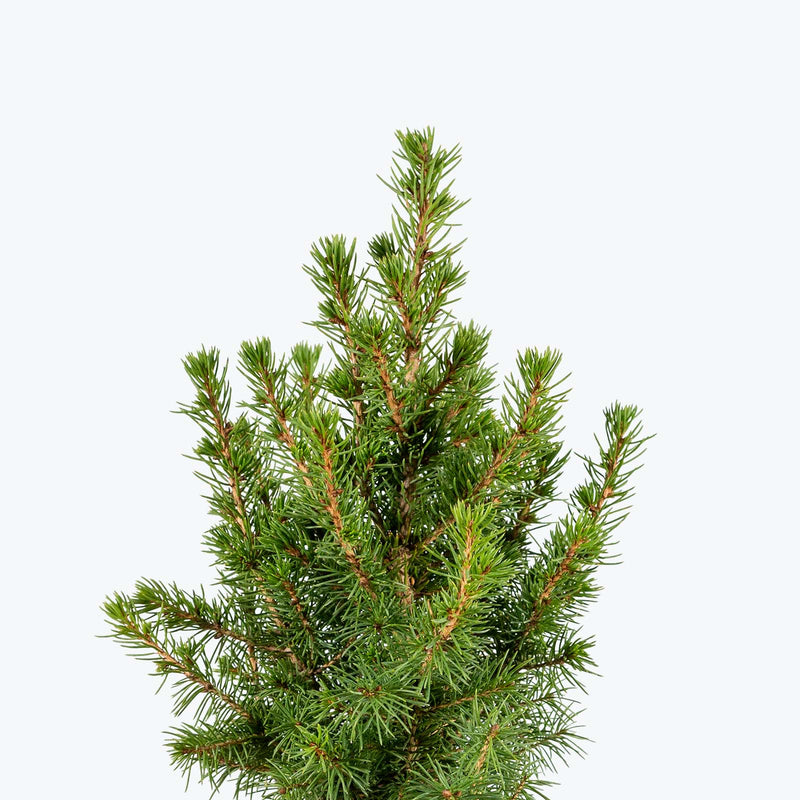
How to care for Dwarf Alberta Spruce
They enjoy some direct sun, but they'll also do well in bright, indirect light. It is best to place this plant somewhere where it will receive some nice morning sun, or a couple hours of afternoon sun, and then indirect light the rest of the day.
They will do best in bright light. A nice bright place inside your home would be on the window sill or a stool that is right next to a window, either with or without blinds, depending on if the plant can handle sun. Remember that plants will grow based on how much light they receive.
Allow the top quarter of the soil to dry before watering again. This usually takes about 3 - 4 days in an average home environment. It will vary depending on the time of year, your environment and lighting conditions. Expect to water more often in brighter light and less often in lower light.
Their humidity requirement is low, so do not mist them or put them in a terrarium.
It does not need misting, but to avoid the needles of your spruce tree getting burned, place your tree away from direct heat sources such as radiators, heater vents, fireplaces and stoves - as it prefers cooler temperatures. It is important, however, for your spruce tree to get as much indirect sunlight as possible. So place it as close to a window as possible in a spot with good air circulation. Because it’s a pot-grown tree, don’t throw yours away after Christmas. It will live very happily outside, growing a bit bigger each year and providing you with a larger tree every Christmas. It can be moved outdoors in the early spring but needs to be hardened off by gradually exposing it to outdoor conditions once again.
You can feel comfortable having this plant around your home in the potential case where your pet feels like nibbling on it. However, we typically recommend keeping your pets from eating any of your houseplants..
View PlantDwarf Banana Plant

How to care for Dwarf Banana Plant
They enjoy some direct sun, but they'll also do well in bright, indirect light. It is best to place this plant somewhere where it will receive some nice morning sun, or a couple of hours of afternoon sun, and then indirect light the rest of the day.
They will thrive in bright light, but also can tolerate medium light. A good medium-light place in your home would be in the middle of a room that has a regular size window. They can be placed anywhere between the middle of the room and the window. Remember that plants will grow based on how much light they receive.
They need to be watered when the top half of the soil is dry to the touch. That usually takes about 1 week in an average home environment. It will vary depending on the time of year, your environment and lighting conditions, but it's always safer to underwater or give the soil a check before you water again. Expect to water more often in brighter light and less often in lower light.
They like a high humidity environment, give them a mist daily or as often as possible. Alternatively, you can put them around a humidifier. Although they won't die if they don't receive enough humidity, their leaves may have some dry, crunchy, or yellow edges.
The leaves are very delicate, ripping easily, so be very careful when handling your Banana plant and make sure it is in a sheltered location if outdoors. Remember that these plants originate in the tropics, so they love as much moisture in the air as possible, as well as warm temperatures. As your plant grows, it may produce offshoots, or babies, when those pups grow and develop a root system of their own – you can go ahead and divide them from the mother plant.
You can feel comfortable having this plant around your home in the potential case where your pet feels like nibbling on it. However, we typically recommend keeping your pets from eating any of your houseplants..
View PlantDwarf Black Olive Bonsai
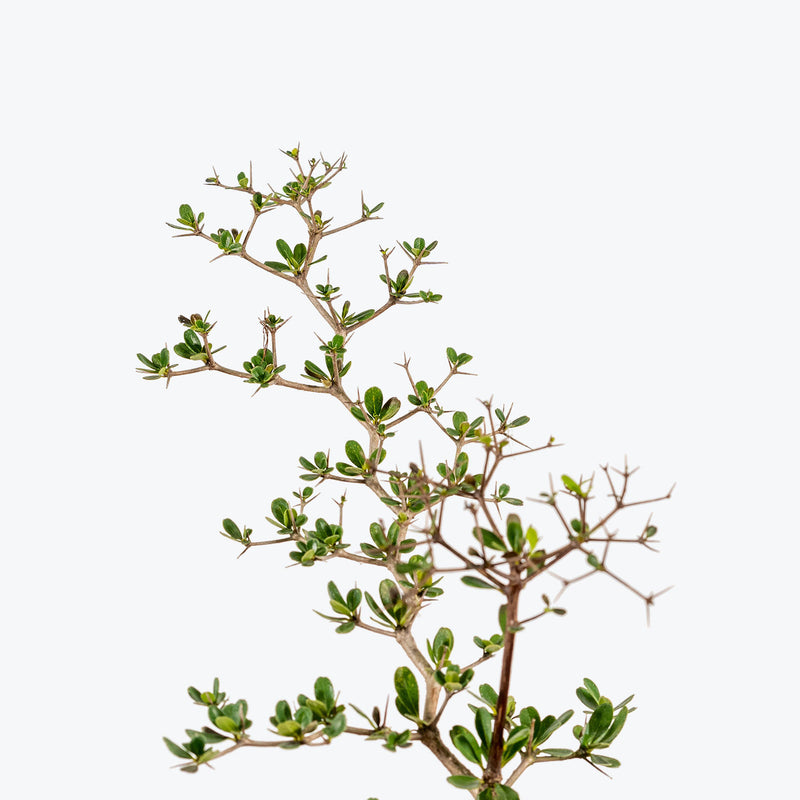
How to care for Dwarf Black Olive Bonsai
Dwarf Black Olive Bonsai enjoys some direct sun, but they'll also do well in bright, indirect light. It is best to place this plant somewhere where it will receive some nice morning sun, or a couple hours of afternoon sun, and then indirect light the rest of the day.
Dwarf Black Olive Bonsai will do best in bright light. A nice bright place inside your home would be on the window sill or a stool that is right next to a window, either with or without blinds, depending on if the plant can handle sun. Remember that plants will grow based on how much light they receive.
Allow the top quarter of the soil to dry before watering Dwarf Black Olive Bonsai again. This usually takes about 3 - 4 days in an average home environment. It will vary depending on the time of year, your environment and lighting conditions. Expect to water more often in brighter light and less often in lower light.
Dwarf Black Olive Bonsai will do well in average humidity environments but will appreciate a little bit of humidity if provided, give them a mist daily or get a humidifier.
Fertilize your Dwarf Black Olive Bonsai every four to six weeks during the growing season with a balanced, slow-release bonsai fertilizer. Pruning and wiring can be performed to shape the tree, but it's best done during the active growing season. Repotting every two to three years in the spring can help maintain its health and vigour, using well-draining bonsai soil.
Dwarf Black Olive Bonsai is moderately toxic and can cause some adverse reactions when ingested so it is best to not let your pets eat it, which we advise for all plants in general. The severity of the reaction will depend on how much of the plant is ingested but, if you know your pet typically does not eat your plants, this plant will be suitable for your home..
View PlantDwarf Jade

How to care for Dwarf Jade
Dwarf Jade enjoys some direct sun, but they'll also do well in bright, indirect light. It is best to place this plant somewhere where it will receive some nice morning sun, or a couple hours of afternoon sun, and then indirect light the rest of the day.
Dwarf Jade will do best in bright light. A nice bright place inside your home would be on the window sill or a stool that is right next to a window, either with or without blinds, depending on if the plant can handle sun. Remember that plants will grow based on how much light they receive.
Dwarf Jade likes the soil to be completely dry before the next watering. That usually takes about 4 weeks in an average home environment. It will vary depending on the time of year, your environment and lighting conditions, but for them, it's always safer to underwater or water when you see signs of lack of water (i.e. wrinkly or soft leaves). Water a little more often in the warmer months.
Dwarf Jade can live in any average home humidity condition and are fairly hardy, but keep them out of an enclosed terrarium.
As with all succulents, overwatering is sure to be fatal, so err on the side of too dry rather than too wet. Never let your Dwarf Jade plant sit in water. If you water from beneath by letting the plant sit in a saucer of water, make sure to pour off any excess water after a few minutes.
Dwarf Jade plant is moderately toxic and can cause some adverse reactions when ingested so it is best to not let your pets eat it, which we advise for all plants in general. The severity of the reaction will depend on how much of the plant is ingested but, if you know your pet typically does not eat your plants, this plant will be suitable for your home..
View PlantDwarf Jade Heart Bonsai
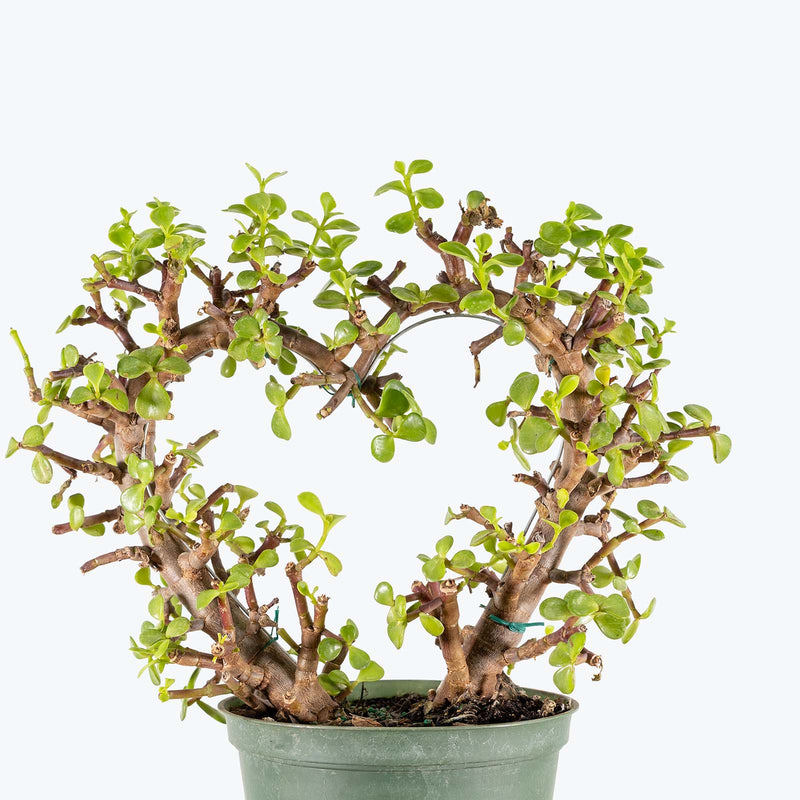
How to care for Dwarf Jade Heart Bonsai
Dwarf Jade Heart Bonsai enjoys some direct sun, but they'll also do well in bright, indirect light. It is best to place this plant somewhere where it will receive some nice morning sun, or a couple hours of afternoon sun, and then indirect light the rest of the day.
Dwarf Jade Heart Bonsai will do best in bright light. A nice bright place inside your home would be on the window sill or a stool that is right next to a window, either with or without blinds, depending on if the plant can handle sun. Remember that plants will grow based on how much light they receive.
Dwarf Jade Heart Bonsai likes the soil to be completely dry before the next watering. That usually takes about 4 weeks in an average home environment. It will vary depending on the time of year, your environment and lighting conditions, but for them, it's always safer to underwater or water when you see signs of lack of water (i.e. wrinkly or soft leaves). Water a little more often in the warmer months.
Dwarf Jade Heart Bonsai can live in any average home humidity condition and are fairly hardy, but keep them out of an enclosed terrarium.
Use a fast-draining cactus or succulent mix and a pot with drainage holes. Prune Dwarf Jade Heart Bonsai regularly to maintain the heart shape and encourage branching. Rotate the plant every few weeks to promote even growth. Fertilize lightly in spring and summer to support healthy foliage.
Dwarf Jade Heart Bonsai is moderately toxic and can cause some adverse reactions when ingested so it is best to not let your pets eat it, which we advise for all plants in general. The severity of the reaction will depend on how much of the plant is ingested but, if you know your pet typically does not eat your plants, this plant will be suitable for your home..
View PlantDwarf Jade Variegated
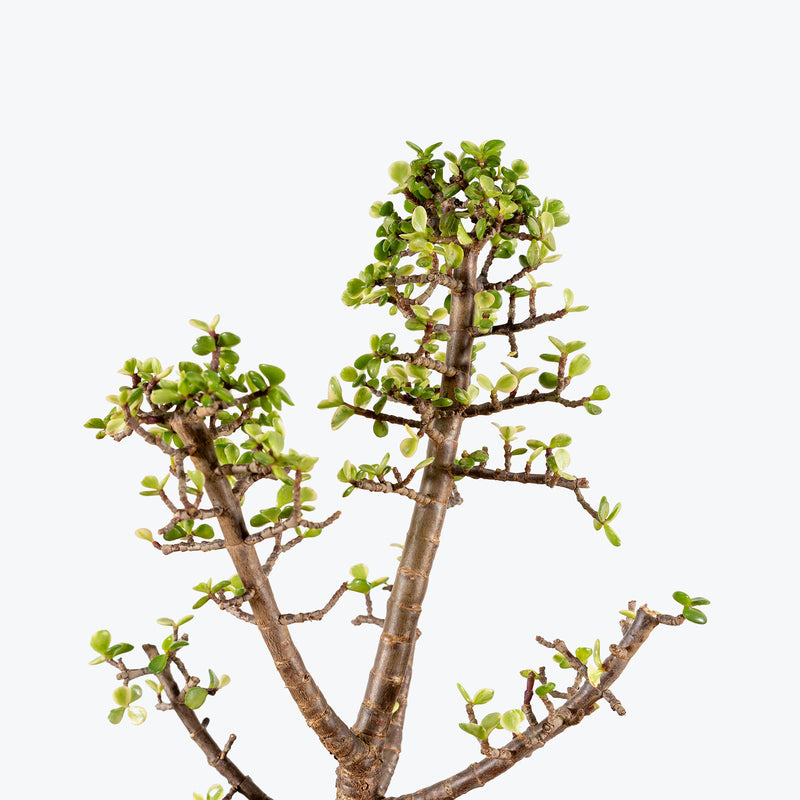
How to care for Dwarf Jade Variegated
Dwarf Jade Variegated enjoys some direct sun, but they'll also do well in bright, indirect light. It is best to place this plant somewhere where it will receive some nice morning sun, or a couple hours of afternoon sun, and then indirect light the rest of the day.
Dwarf Jade Variegated will do best in bright light. A nice bright place inside your home would be on the window sill or a stool that is right next to a window, either with or without blinds, depending on if the plant can handle sun. Remember that plants will grow based on how much light they receive.
Dwarf Jade Variegated likes the soil to be completely dry before the next watering. That usually takes about 4 weeks in an average home environment. It will vary depending on the time of year, your environment and lighting conditions, but for them, it's always safer to underwater or water when you see signs of lack of water (i.e. wrinkly or soft leaves). Water a little more often in the warmer months.
Dwarf Jade Variegated can live in any average home humidity condition and are fairly hardy, but keep them out of an enclosed terrarium.
As with all succulents, overwatering is sure to be fatal, so err on the side of too dry rather than too wet. Never let your Variegated Dwarf Jade plant sit in water. Fertilize with a liquid fertilizer, following the instructions on the fertilizer package for dilution and frequency. Pruning can help maintain its shape and encourage bushier growth. Being succulent, it's also susceptible to pests like mealybugs; inspect regularly and treat as necessary.
Dwarf Jade Variegated is moderately toxic and can cause some adverse reactions when ingested so it is best to not let your pets eat it, which we advise for all plants in general. The severity of the reaction will depend on how much of the plant is ingested but, if you know your pet typically does not eat your plants, this plant will be suitable for your home..
View PlantDwarf Umbrella Ivory
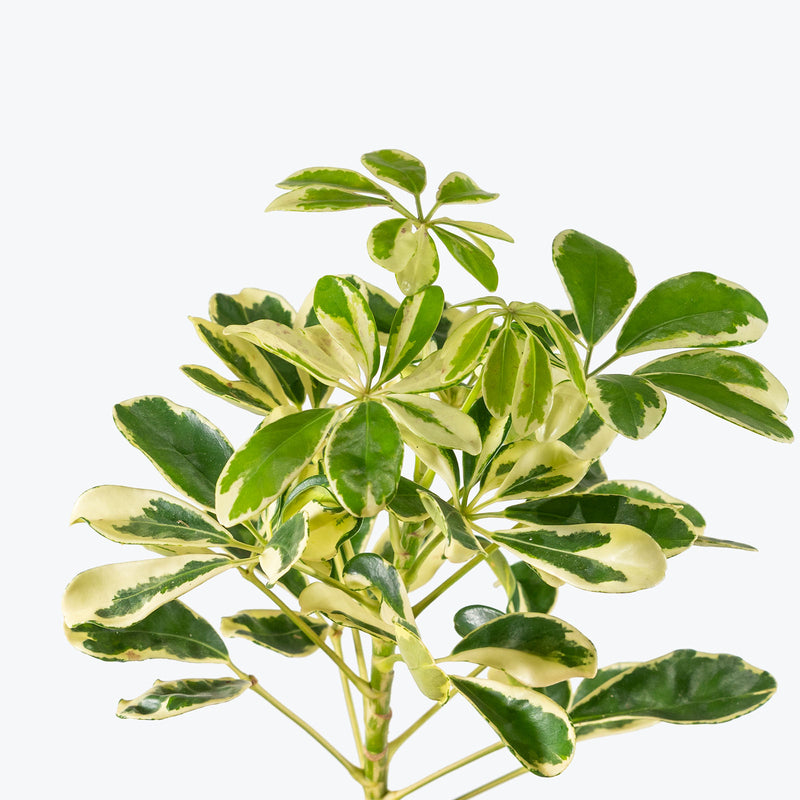
How to care for Dwarf Umbrella Ivory
Dwarf Umbrella Ivory should not be in a position to see the sun directly, although early morning or late evening sun is fine. Filtered sunlight through a sheer curtain is best and most homes are comprised primarily of indirect sunlight. The best spot for them is where they do not see the sun during the majority of the day but still get bright, indirect light.
Dwarf Umbrella Ivory will do well in medium light but will grow faster with brighter light. A good medium-light place in your home would be in the middle of a room that has a regular size window. Remember that plants will grow based on how much light they receive.
Dwarf Umbrella Ivory needs to be watered when the top half of the soil is dry to the touch. That usually takes about 1 week in an average home environment. It will vary depending on the time of year, your environment and lighting conditions, but it's always safer to underwater or give the soil a check before you water again. Expect to water more often in brighter light and less often in lower light.
Dwarf Umbrella Ivory can live in any average home humidity condition and are fairly hardy.
Rotate Dwarf Umbrella Ivory regularly to encourage even growth and prevent leaning toward the light. Wipe the leaves occasionally to keep them glossy and free from dust. Prune lightly to maintain a rounded, compact shape. For best colour, provide bright, indirect light — lower light may cause the creamy variegation to fade. Fertilize monthly during spring and summer to support new leaf growth and colour intensity.
Dwarf Umbrella Ivory is moderately toxic and can cause some adverse reactions when ingested so it is best to not let your pets eat it, which we advise for all plants in general. The severity of the reaction will depend on how much of the plant is ingested but, if you know your pet typically does not eat your plants, this plant will be suitable for your home..
View PlantDwarf Umbrella Moondrop
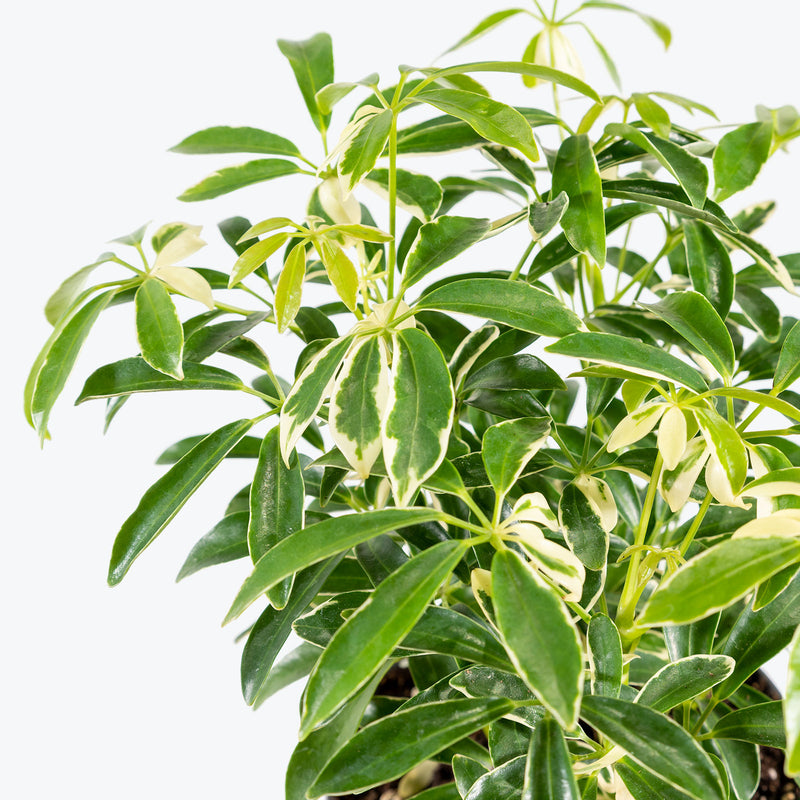
How to care for Dwarf Umbrella Moondrop
Dwarf Umbrella Moondrop should not be in a position to see the sun directly, although early morning or late evening sun is fine. Filtered sunlight through a sheer curtain is best and most homes are comprised primarily of indirect sunlight. The best spot for them is where they do not see the sun during the majority of the day but still get bright, indirect light.
Dwarf Umbrella Moondrop will do well in medium light but will grow faster with brighter light. A good medium-light place in your home would be in the middle of a room that has a regular size window. Remember that plants will grow based on how much light they receive.
Dwarf Umbrella Moondrop needs to be watered when the top half of the soil is dry to the touch. That usually takes about 1 week in an average home environment. It will vary depending on the time of year, your environment and lighting conditions, but it's always safer to underwater or give the soil a check before you water again. Expect to water more often in brighter light and less often in lower light.
Dwarf Umbrella Moondrop can live in any average home humidity condition and are fairly hardy.
Dwarf Umbrella Moondrop can survive in lower light spaces provided there is some source of natural light, although its growth will most likely have less variegation and become "leggy", or stretched out and not very compact. Also, the watering will need to be reduced to prevent overwatering as the risk is heightened when the plant has access to less light and is less productive. Regularly prune back any leggy growth to encourage a bushier appearance and remove any yellowing leaves to keep the plant looking vibrant and healthy.
Dwarf Umbrella Moondrop is moderately toxic and can cause some adverse reactions when ingested so it is best to not let your pets eat it, which we advise for all plants in general. The severity of the reaction will depend on how much of the plant is ingested but, if you know your pet typically does not eat your plants, this plant will be suitable for your home..
View PlantDwarf Umbrella Tree

How to care for Dwarf Umbrella Tree
Dwarf Umbrella Tree should not be in a position to see the sun directly, although early morning or late evening sun is fine. Filtered sunlight through a sheer curtain is best and most homes are comprised primarily of indirect sunlight. The best spot for them is where they do not see the sun during the majority of the day but still get bright, indirect light.
Dwarf Umbrella Tree will thrive in medium to bright light, but also can tolerate low light. A good medium-light place in your home would be in the middle of a room that has a regular size window. They can be placed almost anywhere in the room but remember, plants will grow based on how much light they receive.
Dwarf Umbrella Tree needs to be watered when the top half of the soil is dry to the touch. That usually takes about 1 week in an average home environment. It will vary depending on the time of year, your environment and lighting conditions, but it's always safer to underwater or give the soil a check before you water again. Expect to water more often in brighter light and less often in lower light.
Dwarf Umbrella Tree can live in any average home humidity condition and are fairly hardy.
Dwarf Umbrella Tree can survive in lower light spaces provided there is some source of natural light, although its growth will most likely have less variegation and become "leggy", or stretched out and not very compact. Also, the watering will need to be reduced to prevent overwatering as the risk is heightened when the plant has access to less light and is less productive. Pruning can be done to control its shape and size, which also encourages fuller growth. Regularly clean the leaves with a damp cloth to remove dust and boost photosynthesis.
Dwarf Umbrella Tree is moderately toxic and can cause some adverse reactions when ingested so it is best to not let your pets eat it, which we advise for all plants in general. The severity of the reaction will depend on how much of the plant is ingested but, if you know your pet typically does not eat your plants, this plant will be suitable for your home..
View PlantDwarf Umbrella Tree Variegata

How to care for Dwarf Umbrella Tree Variegata
Dwarf Umbrella Tree Variegata should not be in a position to see the sun directly, although early morning or late evening sun is fine. Filtered sunlight through a sheer curtain is best and most homes are comprised primarily of indirect sunlight. The best spot for them is where they do not see the sun during the majority of the day but still get bright, indirect light.
Dwarf Umbrella Tree Variegata will do well in medium light but will grow faster with brighter light. A good medium-light place in your home would be in the middle of a room that has a regular size window. Remember that plants will grow based on how much light they receive.
Dwarf Umbrella Tree Variegata needs to be watered when the top half of the soil is dry to the touch. That usually takes about 1 week in an average home environment. It will vary depending on the time of year, your environment and lighting conditions, but it's always safer to underwater or give the soil a check before you water again. Expect to water more often in brighter light and less often in lower light.
Dwarf Umbrella Tree Variegata can live in any average home humidity condition and are fairly hardy.
Dwarf Umbrella Tree Variegata can survive in lower light spaces provided there is some source of natural light, although its growth will most likely have less variegation and become "leggy", or stretched out and not very compact. Also, the watering will need to be reduced to prevent overwatering as the risk is heightened when the plant has access to less light and is less productive. Pruning can be done to maintain shape and encourage bushier growth. Regularly check for pests such as aphids and spider mites, and treat as necessary.
Dwarf Umbrella Tree Variegata is moderately toxic and can cause some adverse reactions when ingested so it is best to not let your pets eat it, which we advise for all plants in general. The severity of the reaction will depend on how much of the plant is ingested but, if you know your pet typically does not eat your plants, this plant will be suitable for your home..
View Plant



